Past Winners Image of Research Exhibit
2021 Image of Research Exhibit
The Image of Research at Illinois State competition invited Illinois State students to create or capture one static image of their research and to write a brief narrative explaining how the image relates to their research. Students were asked to choose compelling images to capture the viewers’ attention. The images could take any form, including photographs, drawings, or digital creations, and could convey the research concretely or abstractly.
Submissions were evaluated by a committee of jurors. Many thanks to this years' committee:
- Jessica Benjamin - Painter and Illustrator in Normal, Illinois, MFA from The New York Academy of Art, BFA from Illinois State University. Her work has been shown internationally and featured in the Southampton Art Museum in New York.
- Barry Blinderman - Writer, lecturer, and former director of University Galleries of ISU. He is currently composing, performing, and recording music in the hills of Los Angeles.
- Gail Matesevac - Senior Photographer for a Fortune 50 Company. Visual communicator specializing in Lifestyle, Portraits, Marketing campaigns, and Event photography.
The committee evaluated the submissions for visual impact, originality, and the connection between the student’s image, narrative, and research project. The entries below are the 2021 finalists.
The public at-large voted for the People's Choice Award (Feb22-March 5th) via the Office of Student Research website.
Graduate Finalists
Congratulations to our 2021 Image of Research Finalists and Winners! Winner's names followed by major/program and name of faculty mentor.
-
First Place (TIE): Triston Brown (Anthropology. Kathryn Sampeck) and Sargylana Cherepanova (Painting, Nathania Rubin)
Prize: $200 -
Second Place : Rocky Roque (Communications, Steven Hunt)
Prize: $150 -
Honorable Mention(s): Lindsay Chassey (Psychology, Dan Lannin); Shahrzad Hamzeh (Theater Studies, Jason Reblando); Maggie Demaeged (Biology, Wolfgana Stein)
Prize: $50 -
Peoples' Choice: Raeann Huffman (Agriscience, Nicholas Heller)
Prize: $150
Triston Brown, Cultural Anthropology, Dance and Know You Are a Part
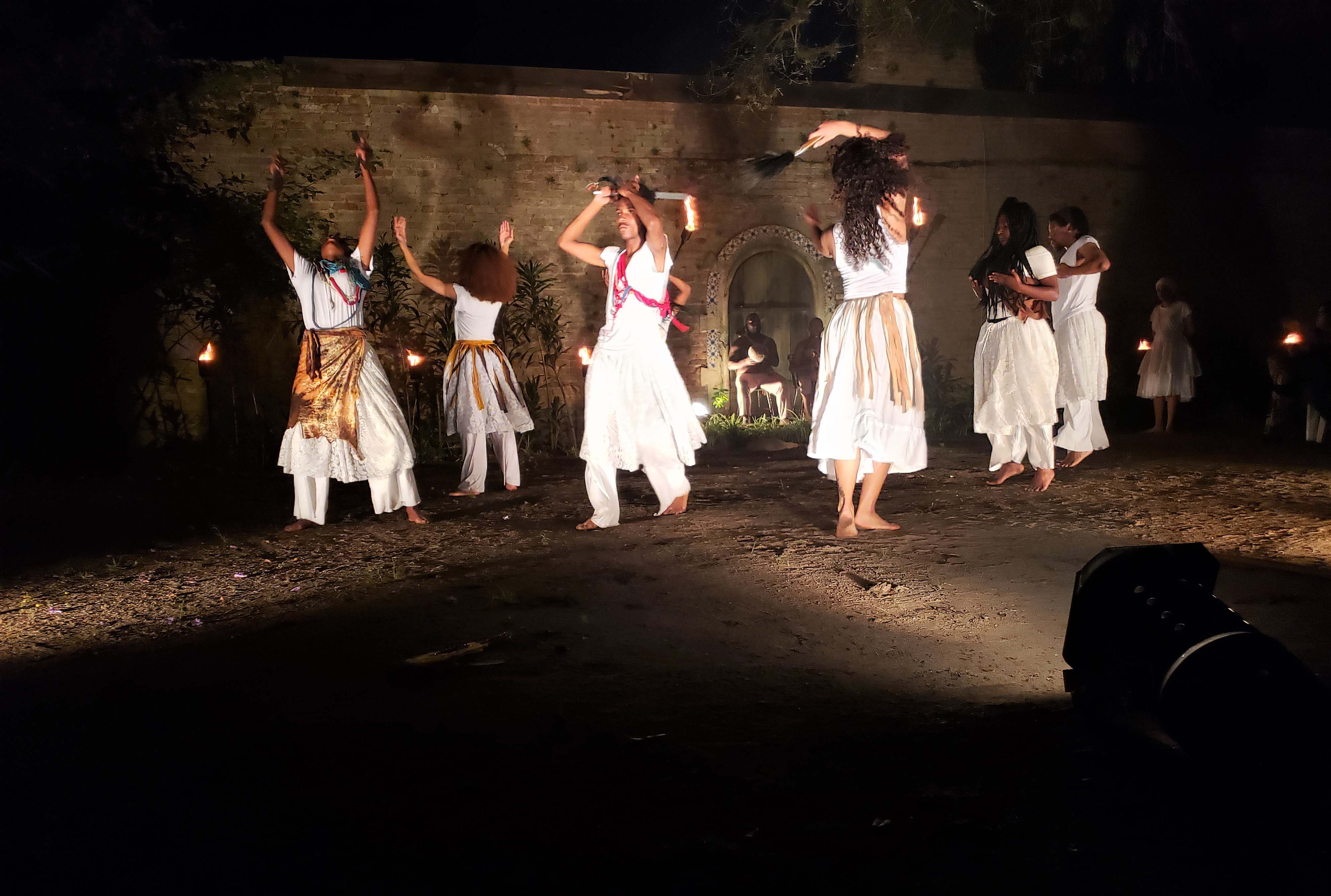
Narrative:My research focuses on the efforts of a dance company to reinsert and centralize Afro-Brazilian experiences within contemporary social life and historical narratives of the city of Pelotas, Brazil. My research foregrounds the collateral of the historical disenfranchisement of Afro-Brazilians. It also underscores race/skin color as hazardously germane to definitions of “Brazilianness.” What I have also shown in my thesis, is that, through performance and community activism, dancers are able to actively challenge national and societal inscriptions and prescriptions meant to confine the Black body/mind. This image, taken during a performance titled “Dança dos Orixás”, embodies the visceral and kinetic nature of social change. My hope is that my research will contribute to and expand attention to Afro-Brazilian identity and performance arts within the literature on African diaspora, dance anthropology, and biopolitics.
Lindsay Chassay, Psychology, Equity, not just equality
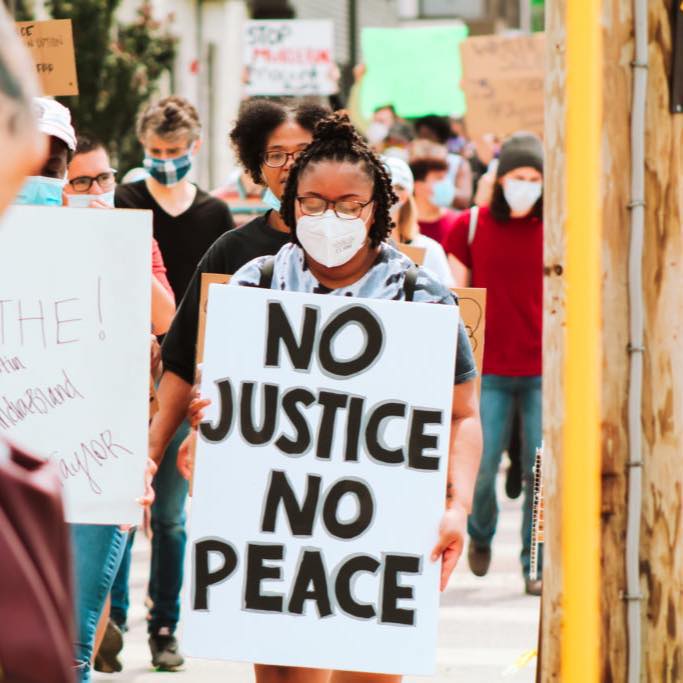
Narrative:In an equitable society, opportunities, resources, and services are distributed fairly. However, in most societies, some groups have greater access than others. In the face of these injustices, social movements have emerged to bring about change. Some citizens become active in such movements even when they are not personally affected; others may be outraged by the inequality and verbally express it yet never take action. My research focuses on understanding the factors that predict a person’s active participation in social justice movements as well as barriers that prevent active participation. This research will have important implications for how to mobilize individuals to participate in activities that are orientated towards social justice.
Sargylana Cherepanova, Painting, Sun, Time and Vivid Dreams
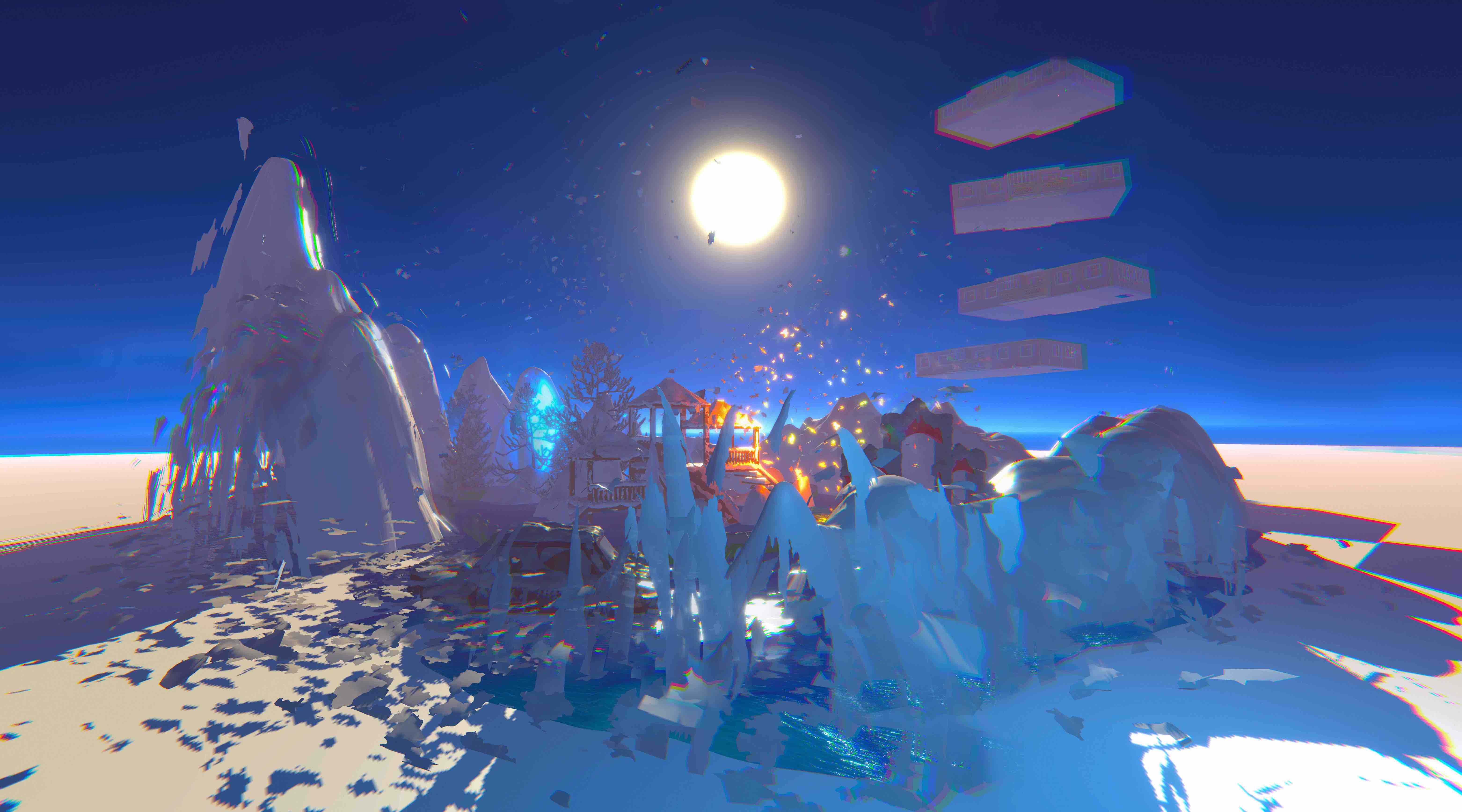
Narrative:My research is focused on incorporating my indigenous Yakut upbringings into the virtual space of videogames. In my culture, we still believe in shamanism and see the world as a complex multi-layered universe filled with spirits. I'm also interested in researching classic videogame questions about reality, consciousness, and artificial intelligence, and how to make a game that is not a game. The image is a scene from my project "The Boring Game". I created the image in Blender and Unity to convey the feeling of when you're trying to remember something, to encapsulate a memory, but somehow details slip away from your mind. The scene is inspired by a playground in my home city Yakutsk and the aesthetics of point cloud data. This is the world of multidimensional time and feverish dreams where the sun never sets.
Maggie Demaegd, Biology, Carcinization

Narrative:Carcinization describes nature’s many attempts to evolve a crab. Several times throughout evolutionary history, non-crab-like organisms have convergently evolved into crab-like forms. Considering that crabs are among the most robust creatures on the planet, it is not hard to understand why nature favors the crab. From the pleasant, tropical waters of the Caribbean to the harsh, icy waters of the artic, crabs not only survive in wildly different environments but thrive. Crustaceans like the green crab, Carcinas maenas, and the marbled crayfish, Procambarus fallax, are fiercely invasive and threaten the wellbeing of communities throughout the world. My research seeks to expose how these animals thrive in different environments by studying their nervous system. Ultimately, their survival depends on functional neuronal activity.
Shahrzad Hamzeh, Theater Studies, Dancing in Quarantine
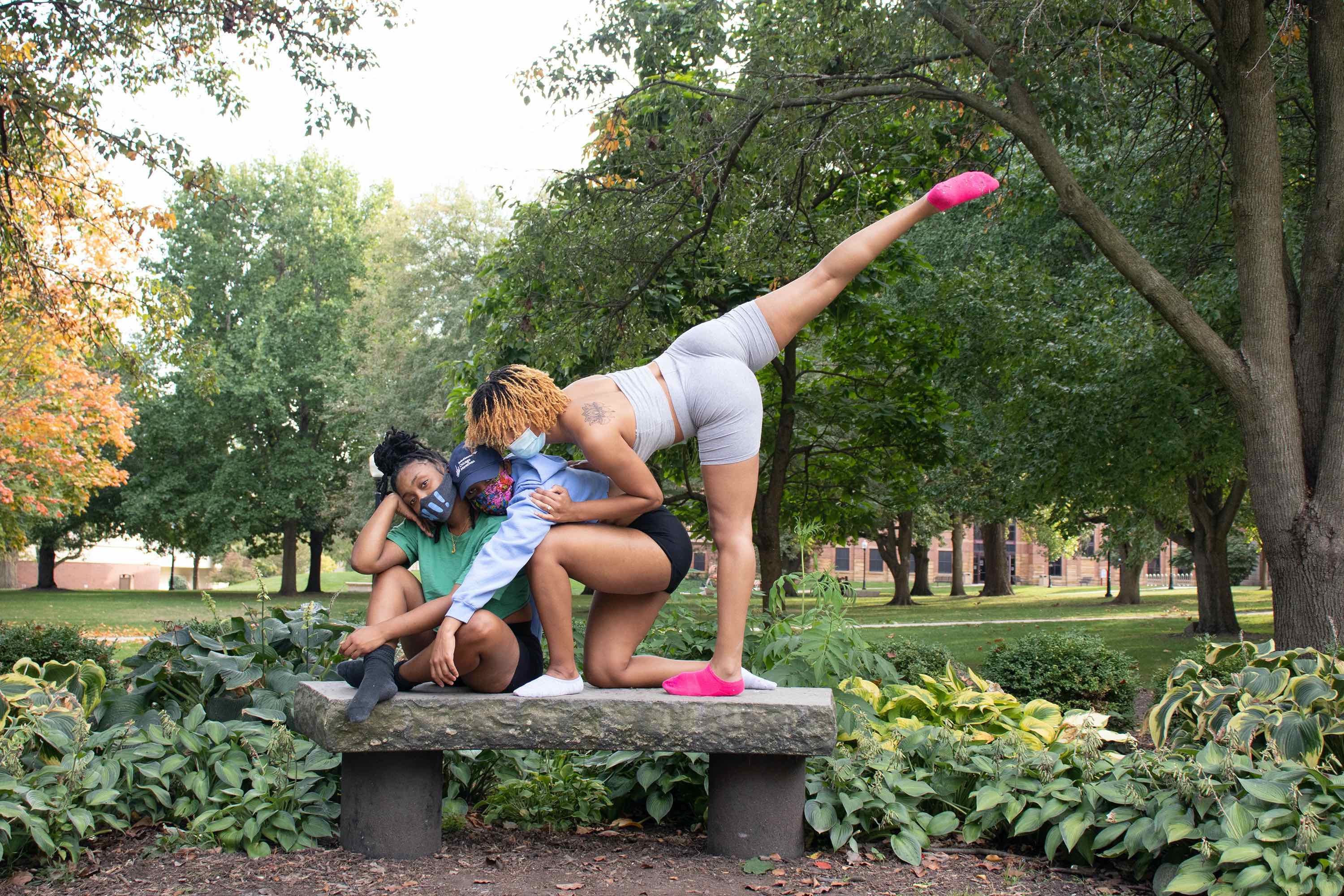
Narrative: My research investigates the impacts of Covid-19 and the quarantines it caused on dancers. The image of dancers wearing masks outdoors shows the resilience and possibilities artists have found during the pandemic. The quarantine enforced isolation and seemed to limit artistic expression. Yet, we discovered together that we could use restraint as a tool to force growth in new directions. The dancers reacted to the objects they found in their surroundings and danced with and to them. They showed unity among themselves even when the dancers did not know each other. I created this image to show that the quarantine did not stop the learning process. Dancers could not look to their mirrored reflections to improve technique, but instead looked inward towards their inner strength and engaged with their environment in new and innovative ways.
Shahrbanoo Hamzeh, Painting, Behind the Doors
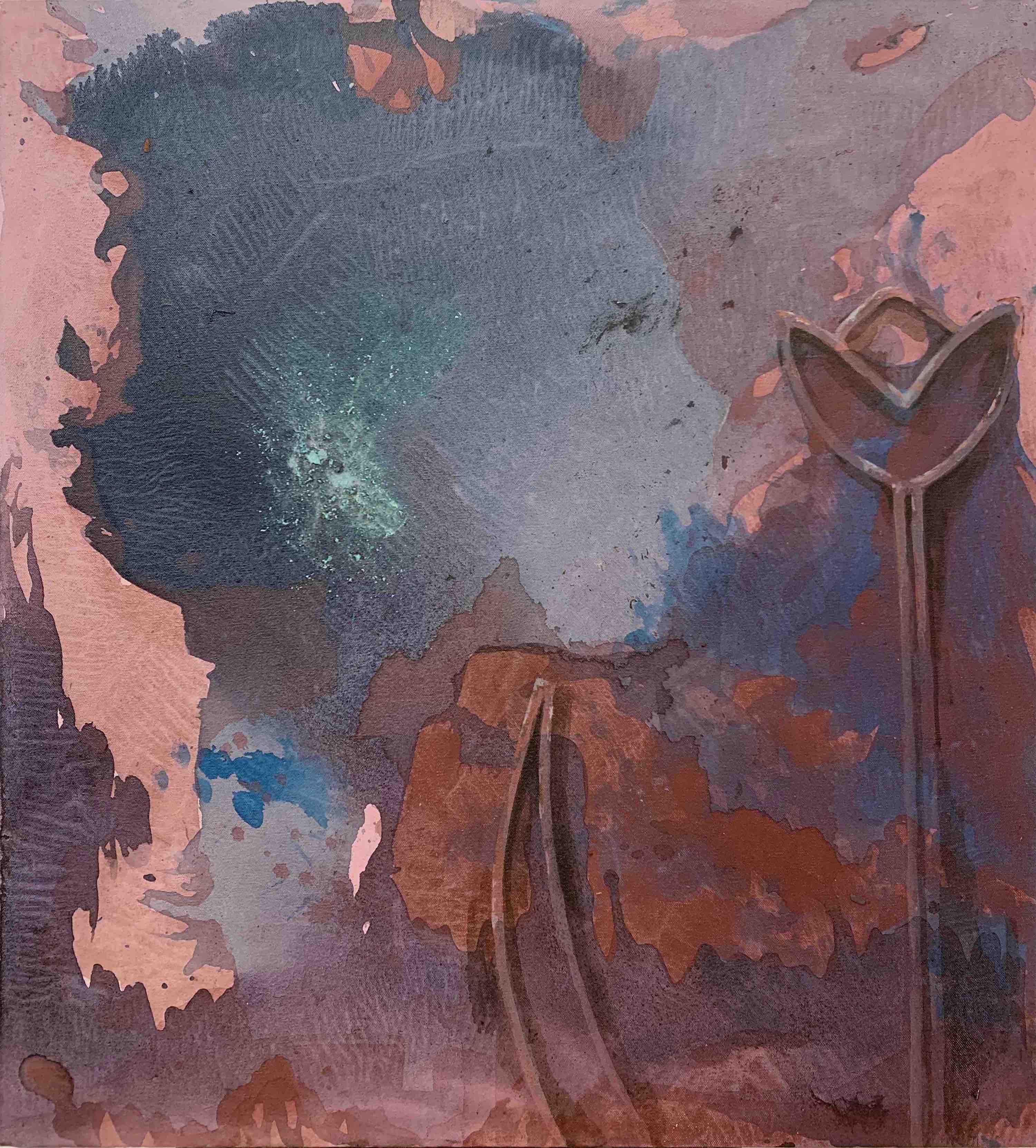
Narrative: I study home, displacement from it, and suffering within or outside of it. I believe our bodies, our domestic spaces, and our homelands are three parallel homes on different levels. Definitions of home are related to definitions of Us versus Others, and these definitions and their relationship to borders and boundaries can be problematic. Borders and the lines we draw around ourselves and others allow authorities to enforce unjust, inhumane, or brutal laws in the absence of public awareness. This is the case with the current regime of my country, Iran. In my paintings, I use imagery of metal doors to talk about what is going on behind the doors and give voice to ongoing brutality towards women in Iran, where femicide is allowed by law in many situations. My color pallet suggests both durability of cold and rusty metal doors and the vulnerability of a body, with lacerations referring to traumas. I think art can bring attention and awareness to this injustice and bring hope for change.
Raeann Huffman, Agriscience, Agronomic Intercropping Systems in Corn and Soybeans
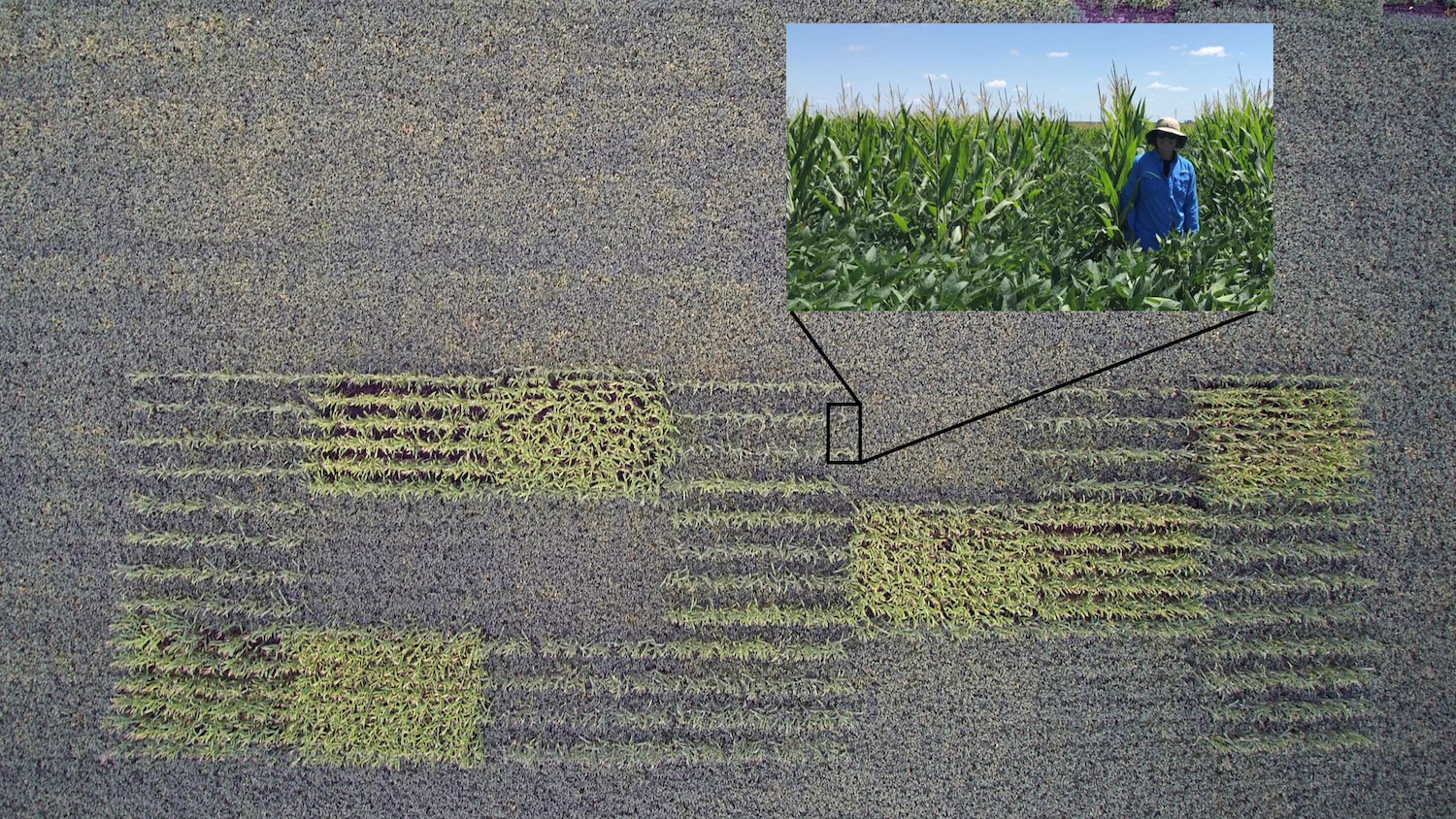
Narrative: In Illinois one sees miles of corn or soybean fields, but they are never planted together in today’s agriculture. Corn and soybeans are valuable commodities contributing to essential products. This image highlights the production system when corn and soybeans are planted together, described as intercrop farming. This aerial image was taken on July 21, 2020 when the corn crop was at maximum height creating seeds and the soybeans were in the middle of flowering. This aerial image was captured by a UAV (unmanned aerial vehicle), a growing technology in agriculture. The image captures the essence of an experiment testing the significance of four popular corn or soybean monoculture management practices and the intercropping treatment. The overall goal of the experiment is to compare the productivity of the different monoculture systems to the intercropping system.
Sohel Rana, Md, Political Science, The Ringyas: No Escape from Suffering?
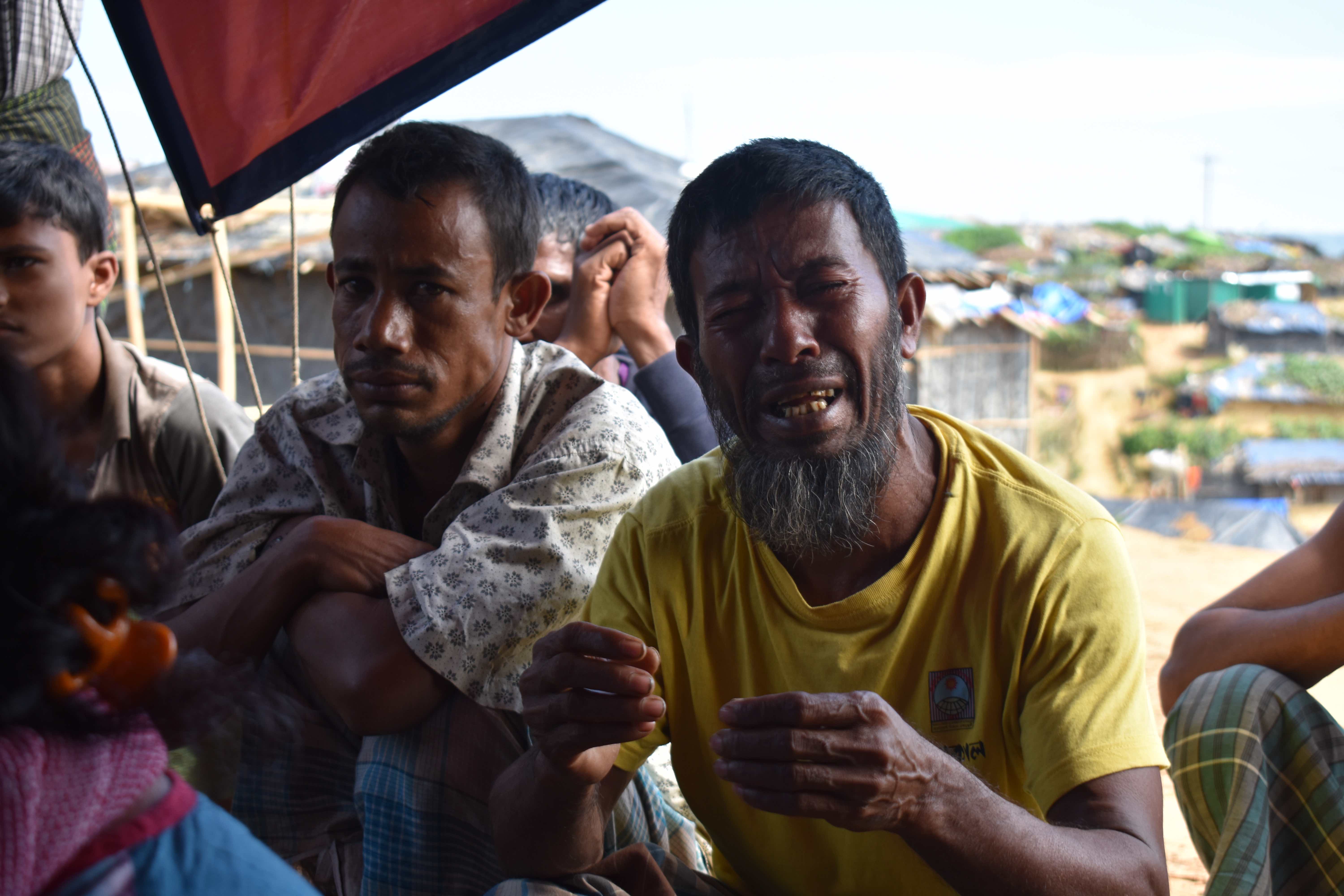
Narrative: Scottish poet Edwin Muir’s poem “The Refugees Born for A Land Unknown” described the precarious journey of refugees who, escaping death and cruelty at home, arrive at their destination only to find “no doors open” leading them to think “the world died many years ago.” The poem describes what Rohingya refugees, “the world’s most persecuted minority,” have been through from escaping massacre at their home country, Myanmar, to currently living in miserable conditions at the refugee camps in Bangladesh. This image reflects the suffering of a group of Rohingyas, representing similar stories of a million refugees living in Bangladesh. My research explores Rohingyas’ experience in Myanmar and Bangladesh through a human security paradigm. I argue that the existing human security perspective is ineffective for protecting the rights of minorities and refugees, and therefore propose a new security paradigm.
Rocky Roque, Communication, Mask for Mask? Queer Hook-up Culture during the COVID-19 Pandemic”
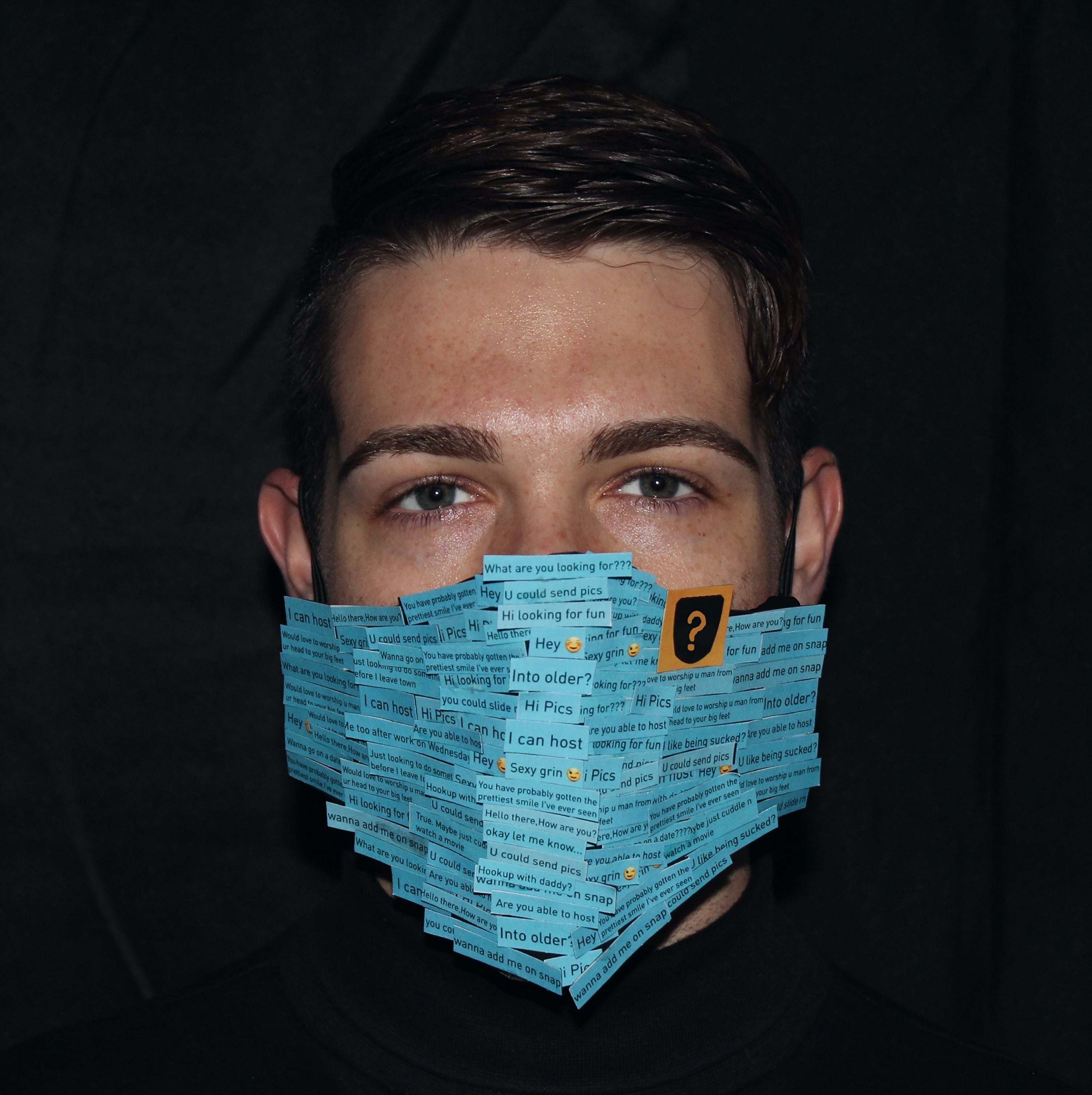
Narrative:Casual sexual intercourse (hook-up) has been identified as a cause of coronavirus transmission, predominantly in the LGBTQ community. Despite pandemic guidelines for people to social distance and quarantine at home to stem transmission, over 49% of gay men reported no change in their hook-up practices during the pandemic. Grindr is the largest social media platform used by queer individuals to engage in hook-ups. In my research, I examine Grindr exchanges that motivate people to meet each other and risk contracting COVID. Additionally, I create a model that critiques the persuasiveness of these exchanges. This image depicts a man who is wearing a face mask displaying common messages people receive on Grindr, representing the dichotomous tension of pursuing sexual desires and upholding social obligations. Additionally, this image is significant to my research because it highlights the excessive number of people potentially breaking CDC guidelines in order to hook-up; creating discourse over safe sex practices during a pandemic.
Isabel Samuel, Theater: Lighting Design, Pope's Arrival in House of Blue Leaves
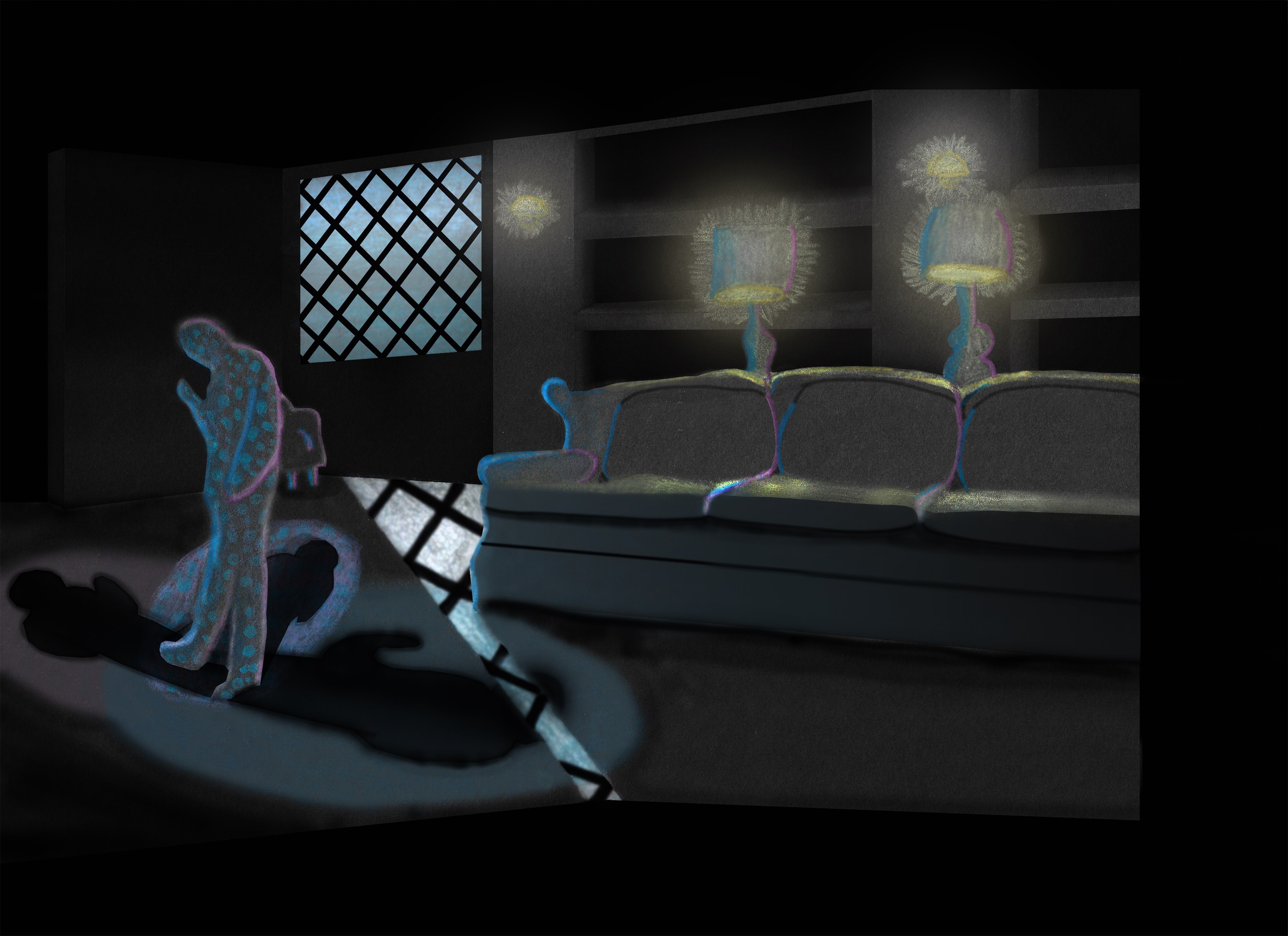
Narrative:Lighting designers we compile research images as a communication tool. Research images allow us to demonstrate ephemeral qualities that exist in our head to the rest of the team working on a production. These research images also serve as a guide to help us generate a rendering of how those ephemeral qualities will actually be recreated on the stage. This image, which pertains to a specific moment in House of Blue Leaves by John Guare, utilizes various qualities of light from research images which is synthesized into one dramatic instance. The radiant light flowing in from the window, the painting shadows on the floor, the low golden glow from the lamps cascading across the couch, and the speckled watery light enveloping the figure onstage are inspired by my research and the themes of the play. This one image is a powerful display of what the lighting will look like on the stage and is a way to communicate internal ideas to the rest of the creative team.
Undergraduate Finalists
-
First Place: Isolde Mckiernan (Molecular and Cellular Biology, Kevin Edwards)
Prize: $200 -
Second Place: Erin Collins (Molecular and Cellular Biology, Shawn Hitchcock)
Prize: $150 -
Honorable Mentions: Rebekah Bollin (Geography, Melissa Heil); Bailey Schejbal (Psychology, Julie Campbell)
Prize: $50 -
Peoples' Choice: Molly Frank (Conservation Biology, Raz Steward)
Prize: $150
Rebekah Bollin, Geography, Dripping Down the Drain
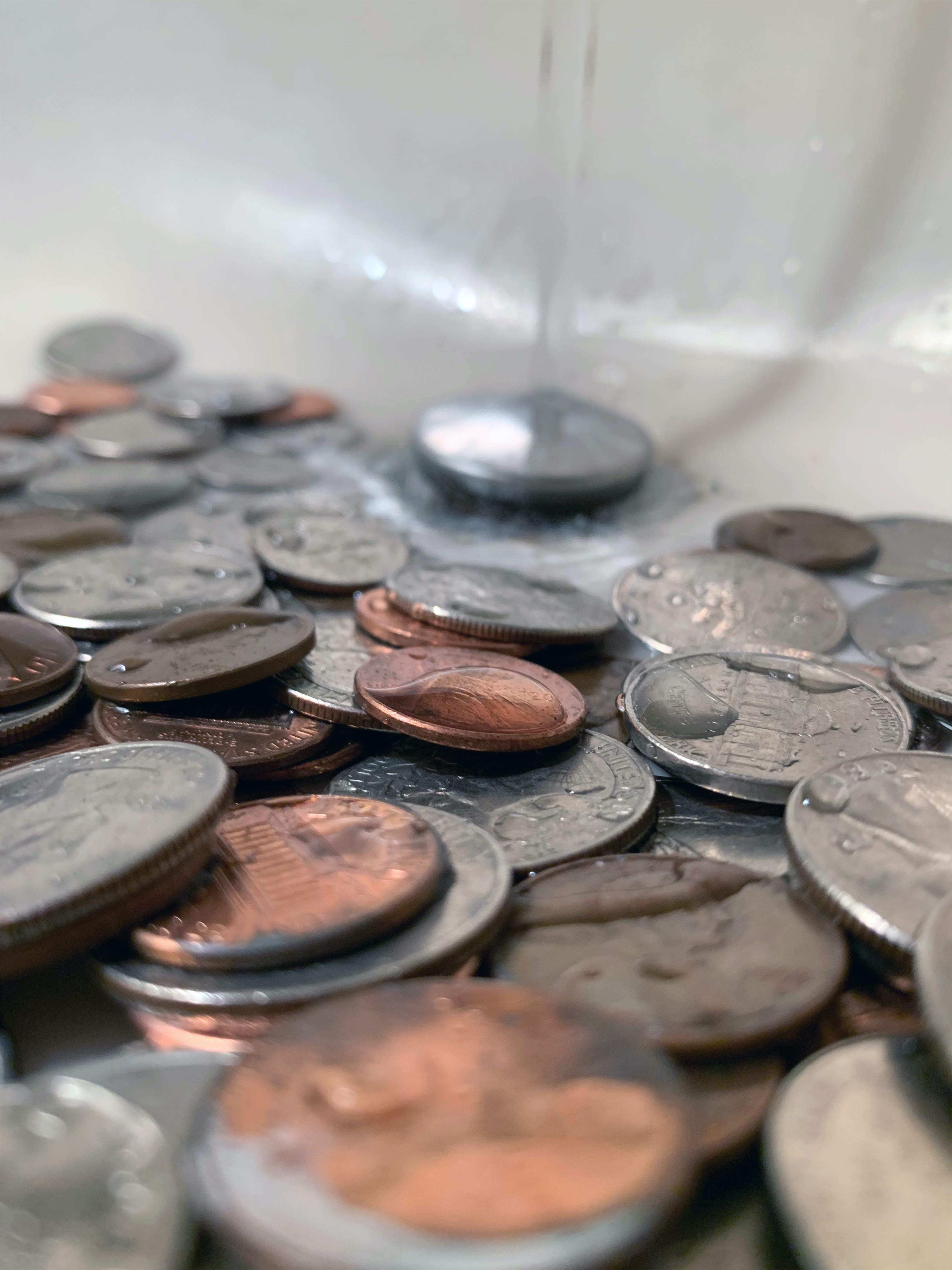
Narrative:According to a 2017 study, 10% of American households are unable to afford their water bills. This creates a massive problem for families across the country where failure to pay leads to hefty late fees and water service disconnection. My research studies the impact of unaffordable water on central Illinois communities. This image was intended to represent the experience of “drowning” in bills simply for the ability to turn on the tap. What begins as spare change slowly accumulates into an overwhelming amount of water debt. This photograph also draws into question the ethics of water bills and whether low-income households have the right to safe and affordable water. The piles of coins dripping down the drain echo a suffocating reality for many families in Illinois State University’s back yard.
Abigail Byrnside, English Education, She's Got Her Head in the Stars
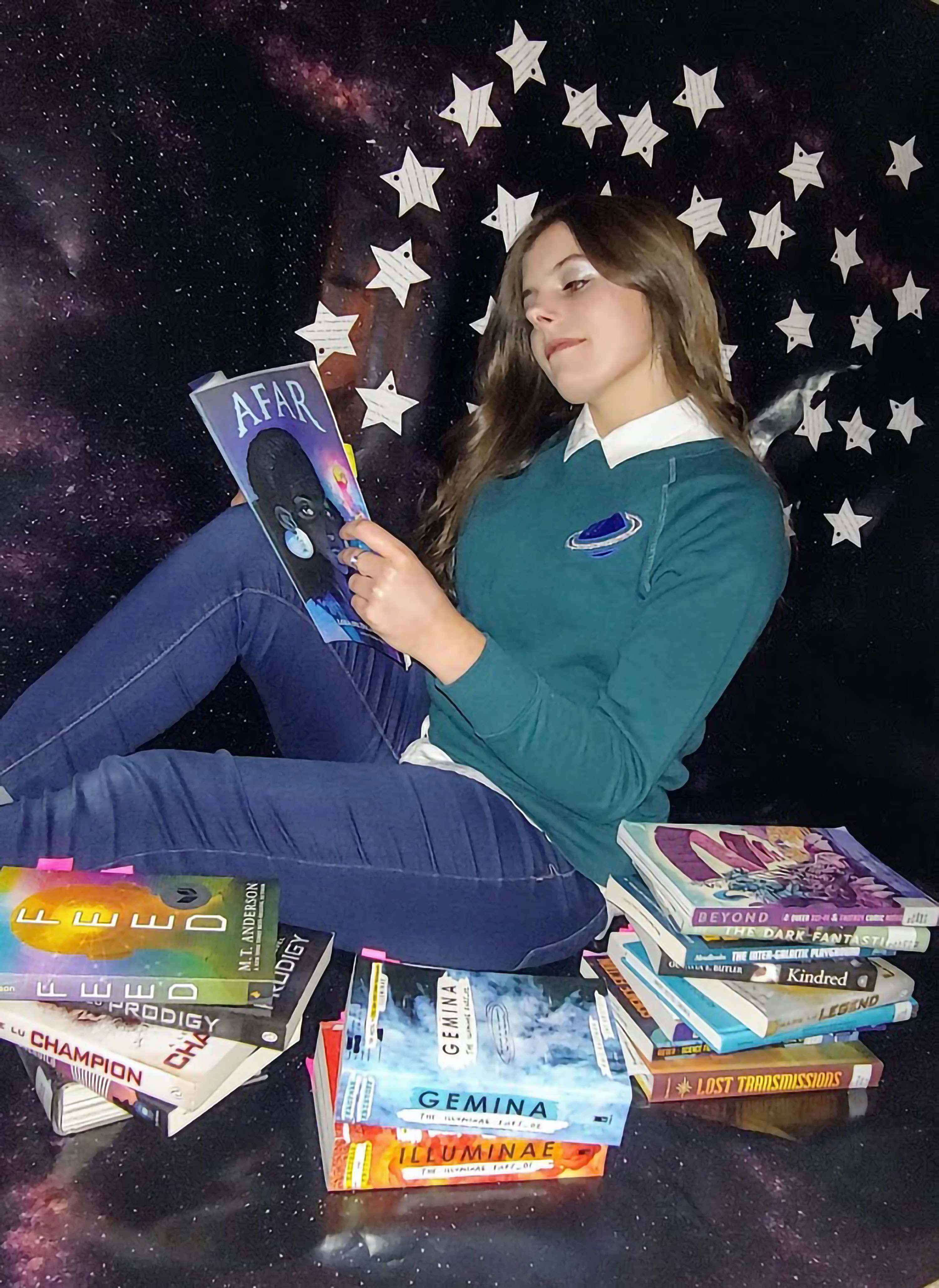
Narrative:Since childhood, I have dreamed of outer space; but as I got older, I realized I was a little more interested in science fiction than science. I am fascinated with the misunderstood genre of science fiction which is rarely considered of academic merit. My research argues that the study of the existence of non-formulaic protagonists and their significance to young adults can give the genre higher literary status. These kinds of protagonists diversify the identities represented in the genre and reflect its readers. In the image, I have surrounded myself with all the Young Adult science fiction books I read this semester. Behind me, my annotated bibliography exists in the shape of stars; each cut-out formulates an argument supported by my primary texts and secondary sources. Ultimately, if I can help change how this genre is perceived, perhaps I can send more readers to the stars.
Audrey Carswell, Graphic Design and Studio Arts, Looking Glass
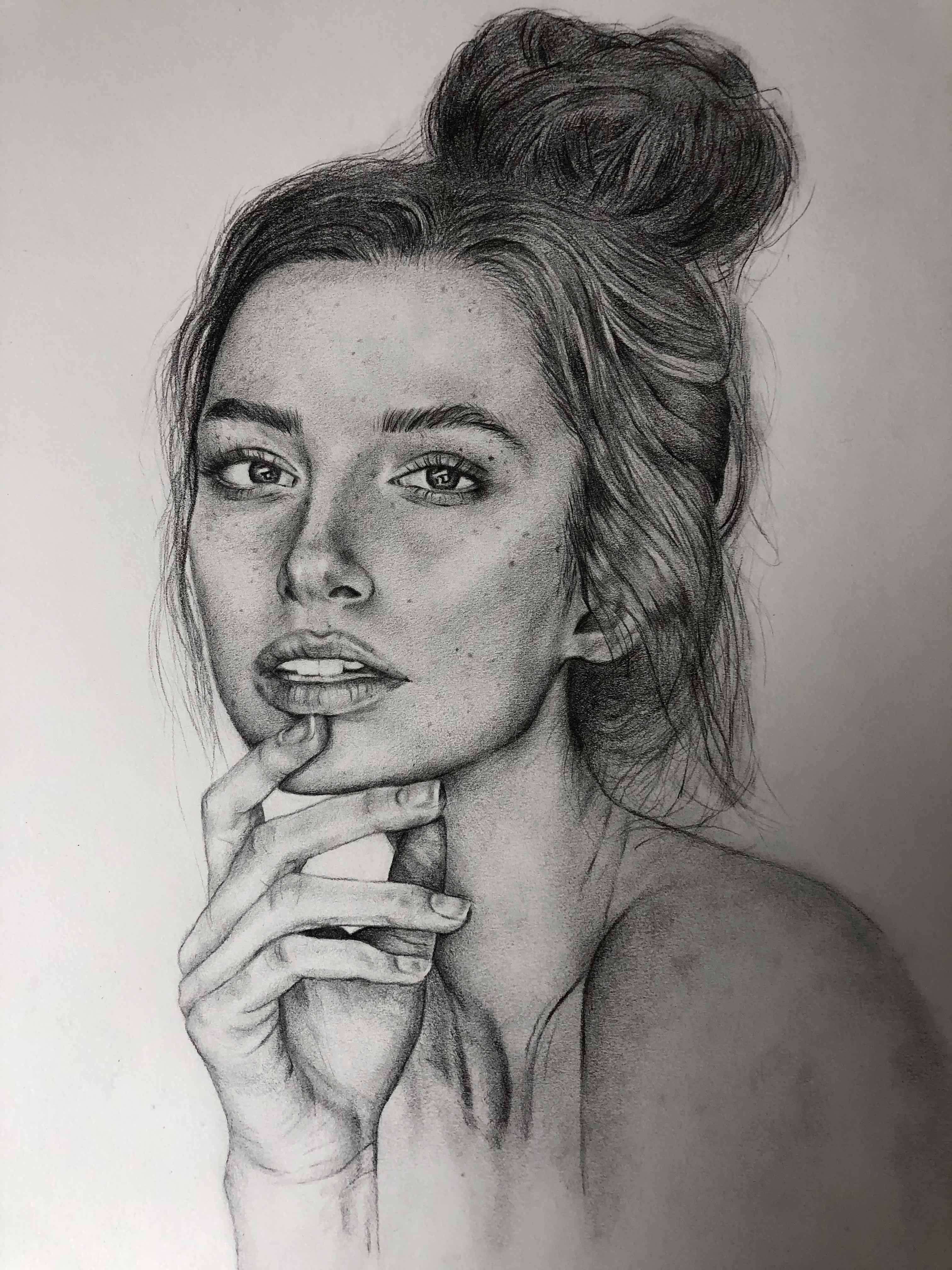
Narrative:My image reflects my research on the topic of personal identity and the human form. While drawing this portrait, I studied many facets of the human figure. I tried to incorporate many components of figure such as hands, neck, chest, shoulders, hair, and most notably, the face. Considering the drawing is centered around the face, I took the most time in my research of this aspect in comparison to the other elements of figure that I studied. Although smaller details such as wrinkles and moles took less time to create, they actually had considerable impact on drawing the face in terms of realism.
Erin Collins, Molecular and Cellular Biology, To be 'S', or not to be 'S'?-- that is the question
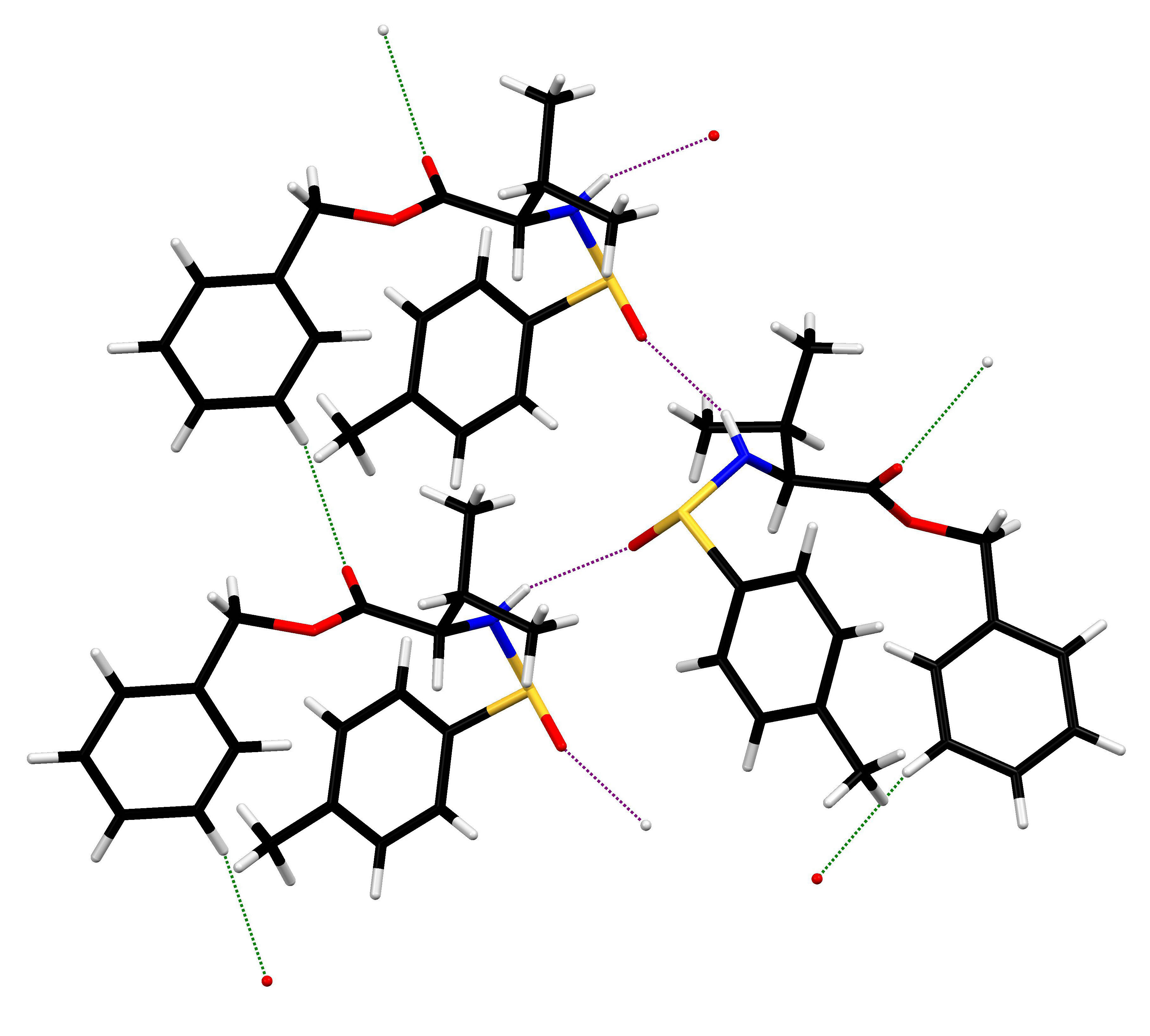
Narrative:The research I conducted focused on developing a class of catalysts capable of creating alternate routes to compounds that can be used in the synthesis of medicines like cinacalcet, a drug used in the treatment of osteoporosis. The photograph is an x-ray crystallography of my compound making hydrogen bonds with itself. An x-ray crystallography is able to show 3-D structures of compounds. This is an essential step in the characterization process of the compounds I created because each diastereomer, which is characterized as R or S, has different chemical and physical properties. From this picture, I was able to determine that this compound is the S diastereomer. From this characterization, in addition to analysis of the diastereomeric ratios, my team was able to improve the synthetic pathway. Hopefully, this work will lead to the development of a better medicine for people struggling with chronic illnesses, like osteoporosis.
Molly Frank, Conservation Biology and Zoology, Relaxing the Reds
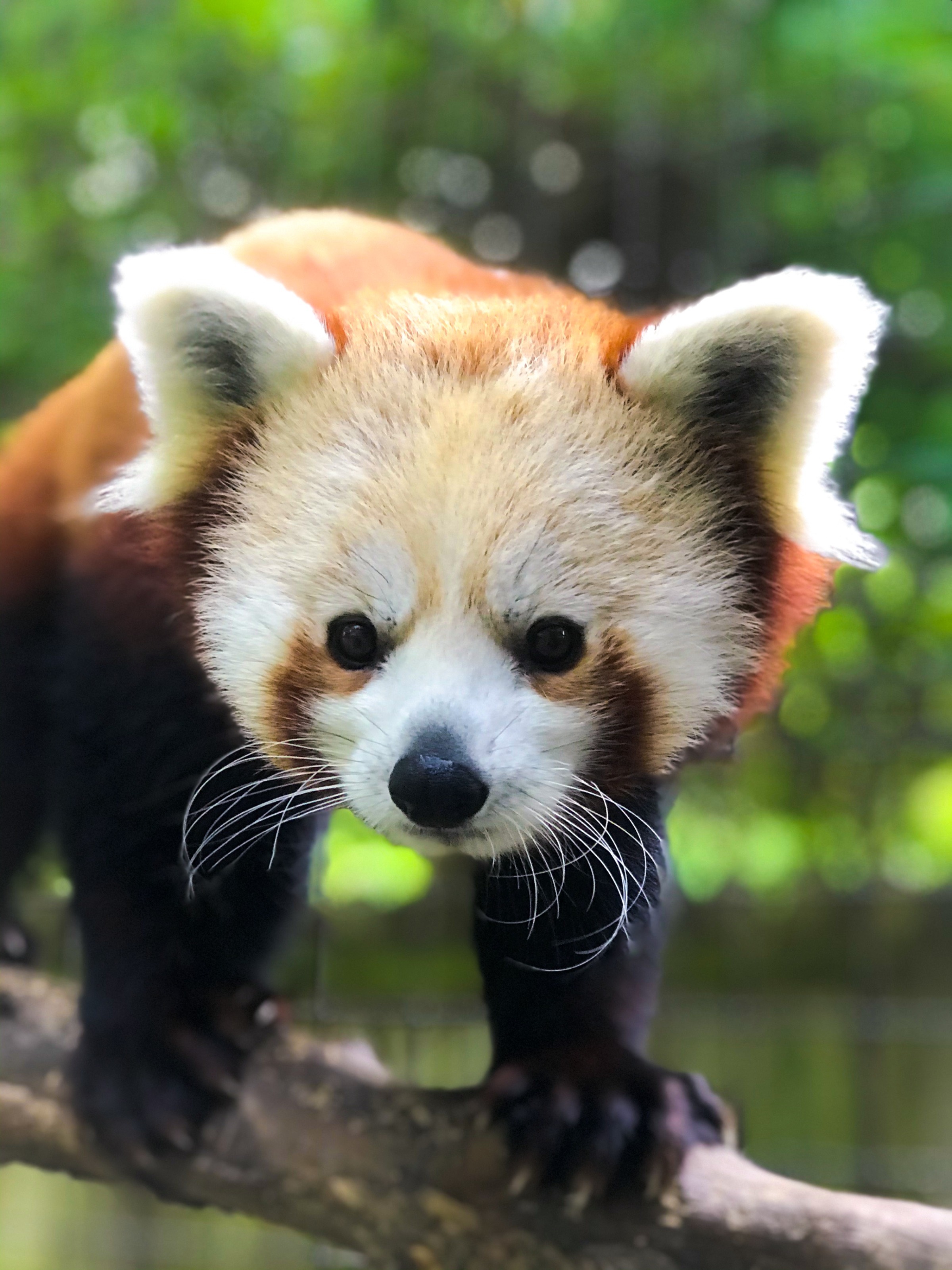
Narrative:This is Cashmere; she is a female red panda at Miller Park Zoo, where I worked as an animal care intern. My project was to socialize the pandas and get them comfortable with zookeeper interactions. Zoos need the animals to be comfortable and not under stress when keepers clean, feed, or even provide medical care. I worked on socialization by spending time in the exhibit, attempting to hand feed, and even talking to the pandas to get them comfortable with our voices and presence. It was an amazing opportunity and rewarding experience to see the animals relax around me and ultimately take food from me (even stepping on my hand in the process a few times). This photograph shows Cashmere comfortable, close to me, and still as I take her portrait.
Paige Hemming, Psychology, Monsters Have Feelings Too: How Emotion-Based Teaching Impacts Social-Emotional Development in Children
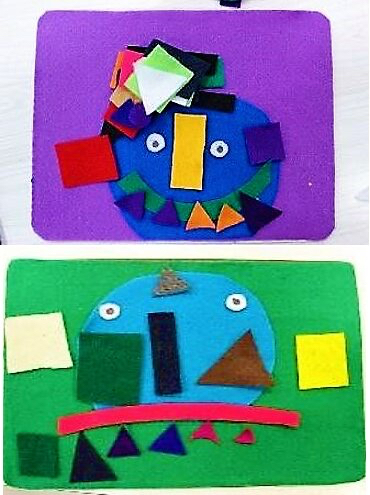
Narrative:You may be thinking: how do these felt monsters relate to social and emotional competencies in children? My answer is “absolutely everything.” The image was created by combining the artwork of two preschool-aged children who were participating in an art program offered by Illinois Art Station. Through this program, our participants received either emotion-based or traditional classroom instruction on art projects, such as the felt monsters shown here. After the children received instruction on how to use felt material to create monsters according to how they were feeling that day, these students were able to illustrate their happiness and sadness through art mediums. My research addresses the importance of implementing instruction on emotion into the classroom setting to aid in social-emotional development and overall school readiness in children. These expressive monsters are just the start to what emotion-based instruction could really do.
Isolde Mckiernan, Molecular and Cellular Biology, Scuttle Sensilla
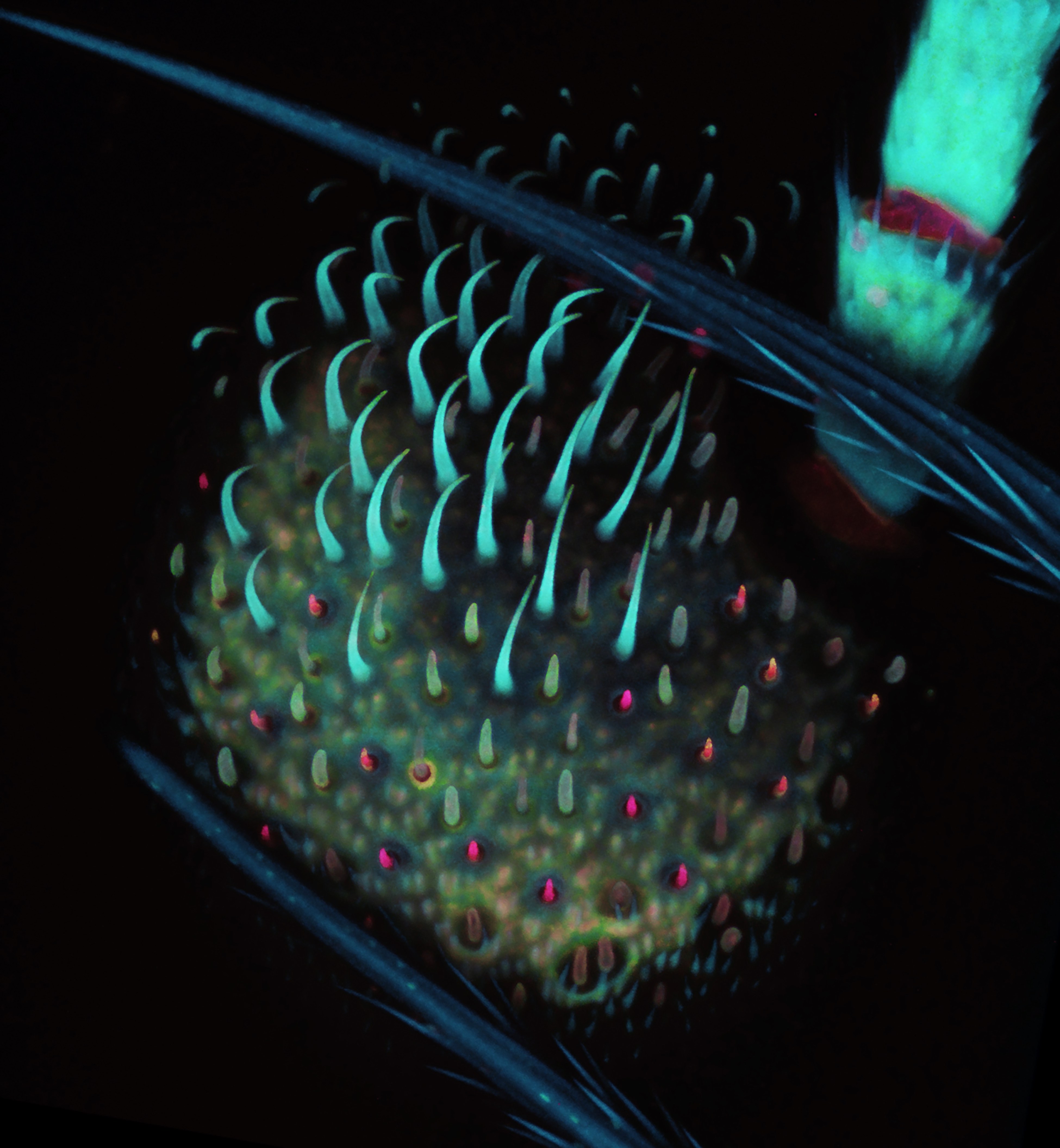
Narrative:This image shows the antennal lobe of Megaselia scalaris, the scuttle fly, using fluorescence lifetime imaging (FLIM). The scuttle fly, AKA “coffin fly”, is known for its carnivorous nature and ability to burrow deep into the ground and enter coffins. FLIM can distinguish among different chemicals based on how quickly they emit photons after absorbing light; this property is color-coded in the FLIM image. FLIM has rarely been used to investigate the properties of insect cuticle or external sense organs. Here, we use live, 3D FLIM microscopy to show that the antenna of a scuttle fly exhibits strong differentiation among different types of sense organs. The hairs in this image are mostly grooved pegs (small pink hairs) and sensilla trichodea (long turquoise). The different fluorescent properties may reflect mechanical specializations for different sensory modes.
Bailey Schejbal, Pyschology, Maternal Influence on Construction Ability

Narrative:This picture of a mother stacking blocks represents our research question: do infants demonstrate an increase in construction behaviors if their mother models high levels of construction behavior? Through observations of videos of 31 infants in a construction task and five-minute videos of the infants with their parent, we have been able to address this question. For our experiment, mothers were given blocks and instructed to play with their infant as they normally do. These sessions were videotaped and later coded for how often play and construction interactions occurred, as well as which hand the mother used. From here, we were able to characterize a mother as a low, medium, or high constructor based on amount of construction that occurred. Infants were also categorized based on amount of construction. We predict that if a mother is high constructor then their infant will also be a high constructor.
Ian Seger-Held, Biochemistry, The Effect of Strontium Compounds on Leishmania Tarantolae
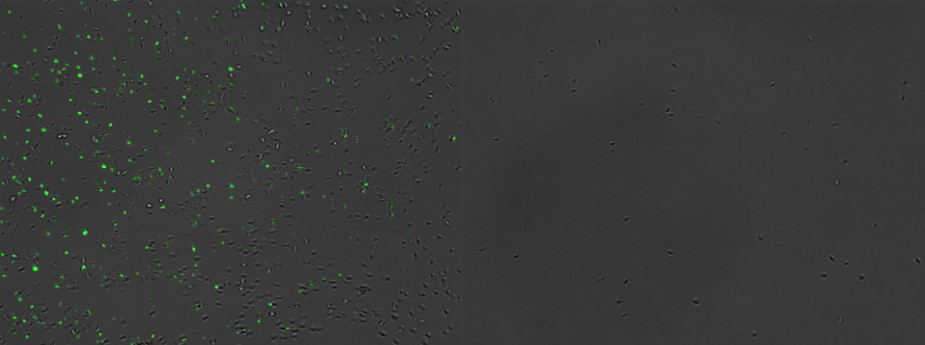
Narrative:This microscopic image represents my research because it depicts a cluster of Leishmania cells with and without the addition of a strontium compound added to the culture. The left of the image shows the control cells without the addition of a strontium compound and the right section shows the cells with the addition of a strontium compound. The green fluorescence exhibited in the left image is a result of nitric oxide production within the Leishmania cells whereas this fluorescence is mostly absent in the cells with the compound addition. Reduced fluorescence represents lower nitric oxide production in the cells due to the compound. The cell viability can be determined clearly as fewer cells are present in the right section than in the left section. Reduced production of nitric oxide and reduced cell viability are both positive outcomes of compound addition and would likely reduce cell infectivity.
2020 Image of Research Exhibit
The inaugural Image of Research at Illinois State competition invited Illinois State students to create or capture one static image of their research and to write a brief narrative explaining how the image relates to their research. Students were asked to choose compelling images to capture the viewers’ attention. The images could take any form, including photographs, drawings, or digital creations, and could convey the research concretely or abstractly.
Submissions were evaluated by a committee of jurors: Mitch Brinker, Director of Art at State Farm Insurance Company; Megan Kathol-Bersett, Interim Director of Illinois Art Station, and Alfonso Gosalbez Berenguer, artist and teacher of Spanish at Tri-Valley Highschool. The committee evaluated the submissions for visual impact, originality, and the connection between the student’s image, narrative, and research project. The entries below are the 2020 finalists.
The Peoples' Choice Award was conducted via Facebook.
Graduate Winners and Finalists
Congratulations to our 2020 Image of Research Winners! Thank you to our panel of judges and to all who voted in the Peoples' Choice competition.
-
First Place: Brett Williams "A Little Light Reading"
Prize: $200 -
Second Place (tie): Rachael DiSciullo "For Whom Does the Male Bird Sing" and Ian Rines "Cricket Conflict"
Prizes: $150
Prize: $150 -
Honorable Mentions: Julen Carrasco Oteo "Tics' Spyglass" and Rocky Roque "Recoloring a Colorless Community: The Rhetoric and Discourse over the New Pride Flag"
Prize: $50 -
Peoples' Choice: Hannah Harris "Effects of Graston Technique on Blood Flow in the Upper Trapezius"
Prize: $150
Julen Carrasco Oteo, Languages Literatures, and Culture, Tics' Spyglass
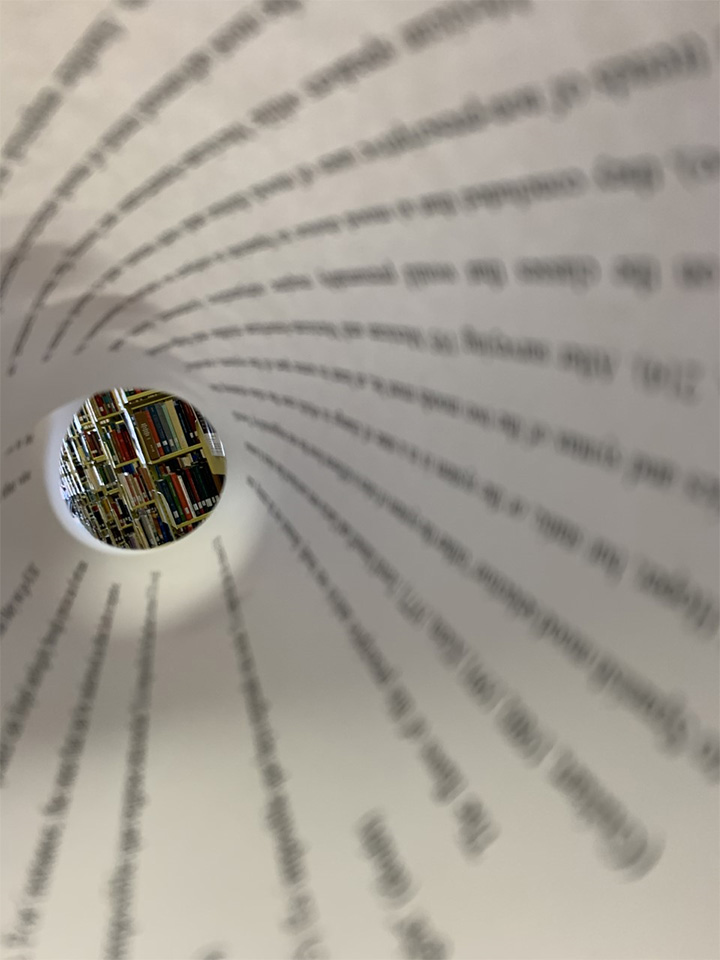
Narrative:Captain Tics headed the tiny ship towards the Island of the Giants. The Sun beams cut off its already cracked profile. Seaweed covered the twisted high tide line and colorful boulders were scattered all over the coast. In spite of the erosion, Tics could even make out some inscriptions carved on some of the rocks. Unfortunately, most of them were crumbled as if they would have been tossed from afar. “It looks like the lack of a clear-cut argument also infuriates people around here”. Tics roared with laughter while putting the paper-thin spyglass away. Nobody else laughed. The hustle and bustle of the deck made it difficult for anybody else there to hear those frequent sassy comments. Moments later, a crew member, who had just finished tying up the loose ends of ambiguity, approached the captain and said, “But why the Island of the Giants captain? Much older and experienced crews have looked for answers to mood selection there”. Tics gazed at the sweaty crew. Many of them sported ill-looking scars, some shabby tattoos, and others both. Many investigations on syntax came to Tics’ mind. “There we will stand for there is nothing more encouraging than an attainable truth”.
Rachael DiSciullo, Biology, For whom does the male bird sing?
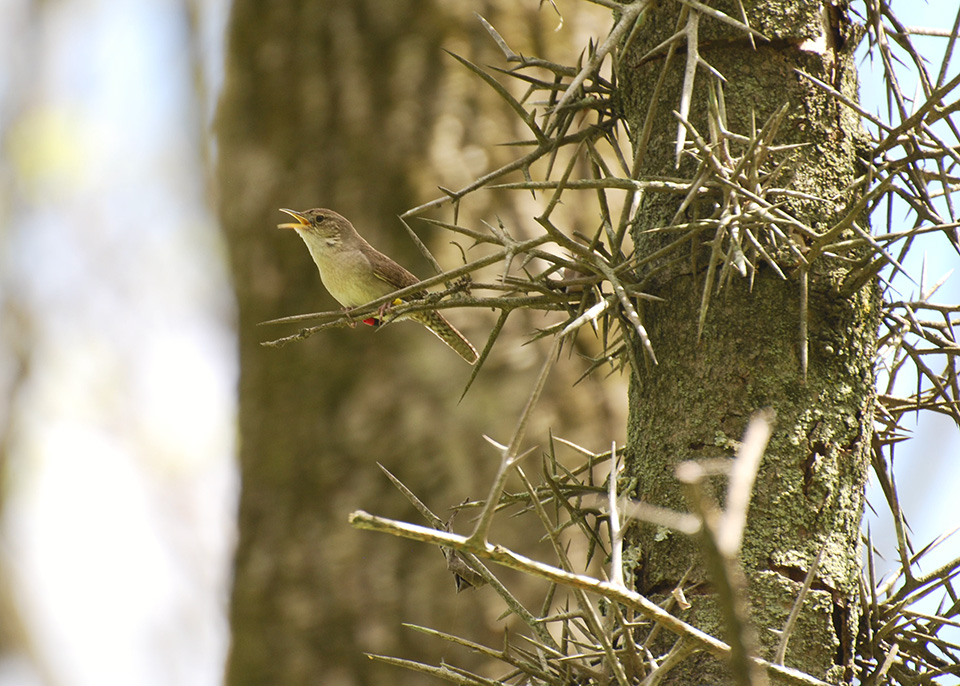
Narrative:Here, a male house wren (Troglodytes aedon) sings with gusto on a honey locust tree (Gleditsia triacanthos) near his nestbox in the Merwin Nature Preserve near Lexington, IL. It is widely understood that male bird song is an honest signal of vigor to other males in competition for territory and mates, and of quality to females for mating. Yet, in many species, it is unknown which particular components of song elicit the most intense competition in males or are most attractive to females. The house wren is one such species. Male house wrens, like the one pictured here, sing highly varied, multi-component songs that appear to be important in male competition and female choice, but the specific song components that promote success in these contexts remain unknown. My research focuses on identifying what role different male song components play in male competition and female choice, to better understand how sexual selection (a mechanism of evolution) has directly and indirectly shaped this elaborate trait. This image is reflective of the unknowns I face in my work—we see that the male sings, but we do not yet know how that song, or the particular components therein, relate to his mating success.
Sylvia Findlay, Education, Breaking Barriers: Refugee Education
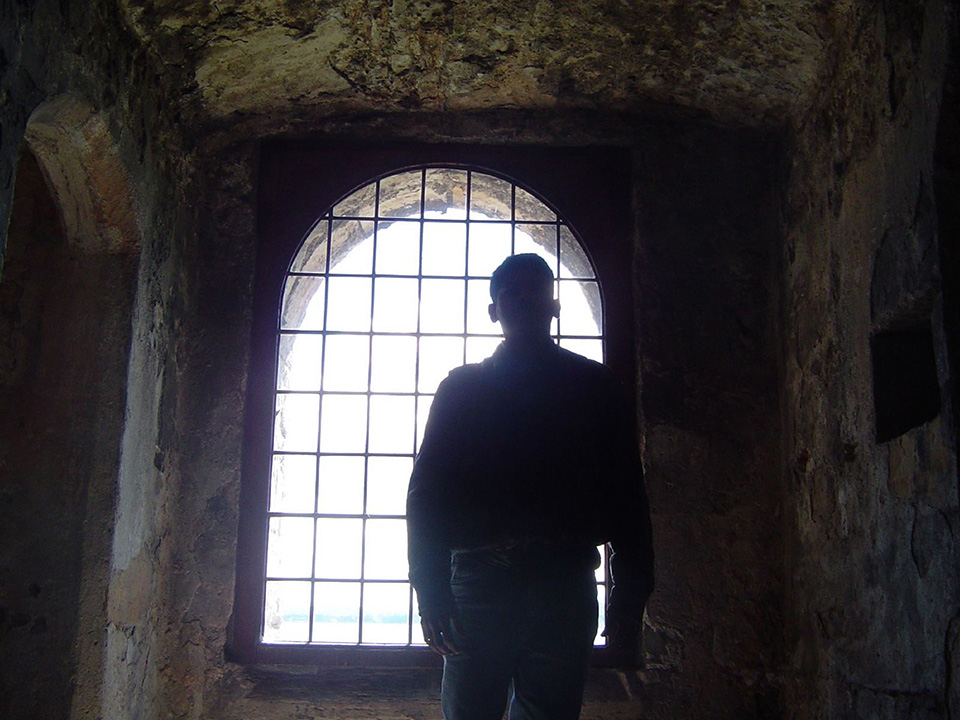
Narrative:The image is of a young refugee who is shackled by the war conditions. The bars behind him demonstrate that barriers that exists between him and his ability to pursue his education amidst the turmoil. It is no surprise as several barriers exist between refugees and education including obtaining transcripts, qualified teachers, infrastructure and so on. Despite governmental and agency efforts including frameworks for the rehabilitation of the refugee population, education has taken a back seat and is not often included in these emergency responses. Encouraging these young men and women to pursue higher education and inculcating the lost hope among the refugee population is the need of the hour. My argument is that from a social justice perspective, institutional leaders should initiate policies and processes that break the barriers for refugee students to access education, and to enable them to pursue opportunities to enhance their developmental potential that contributes to rebuilding their post-conflict nations. My research is to inquire about the perspectives of university leadership in U.S. institutions towards refugee student enrollment for both undergraduate and graduate programs along the lines of policy changes for admission requirements, student services, faculty training, and curriculum changes. Let’s bring back the light!
Shahrzad Hamzeh, Theater, Persian Dance
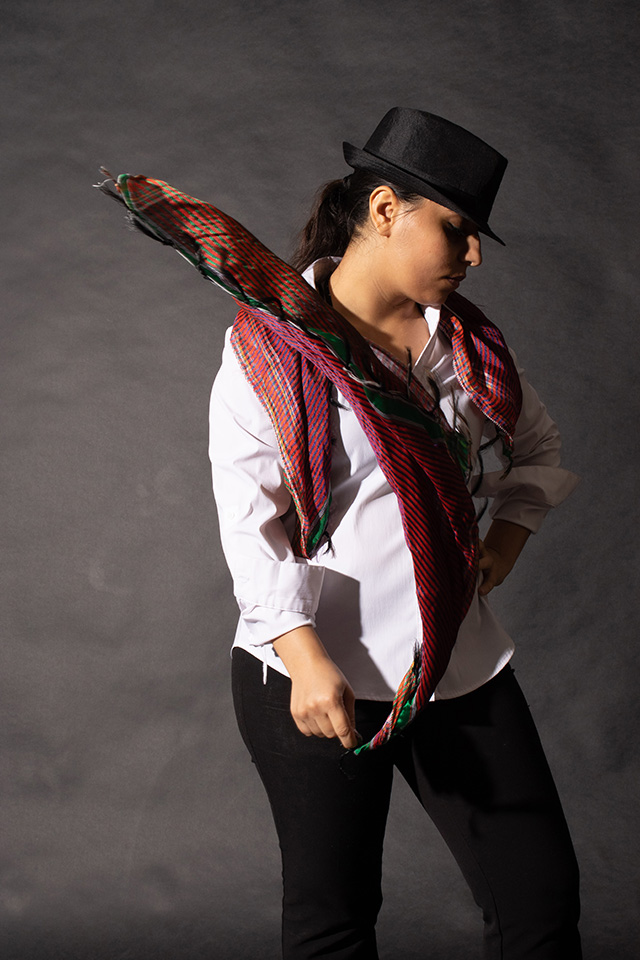
Narrative:I remember the fear I had when feeling the need to get up and dance to the music playing in a party. My mum would say we don’t want people to say how a cantor’s, a religious singer’s, daughter can dance. I must dance when I feel down, to make sense of the cruelty of the world. I had to be careful not to do anything that resembled rhythmic movements. Once as I was crossing the street with one of my friends, a boy, I did a turn holding his hand. He said he would never approve of his partner doing things like that, as it is breaking a taboo. I came here to get away from such judgment. Little did I know that on this side of the world, people do not even know that Persian dance exists! That is why I decided to research History of Persian dance: in order to give it its due recognition. I am most interested in researching Baba Karam, known for its jazz-looking costume including the handkerchiefs and the hat, all of which are essential to the movements involved in this Persian style of dance.
Shahrbanoo Hamzeh, Art, welcoming in the front door
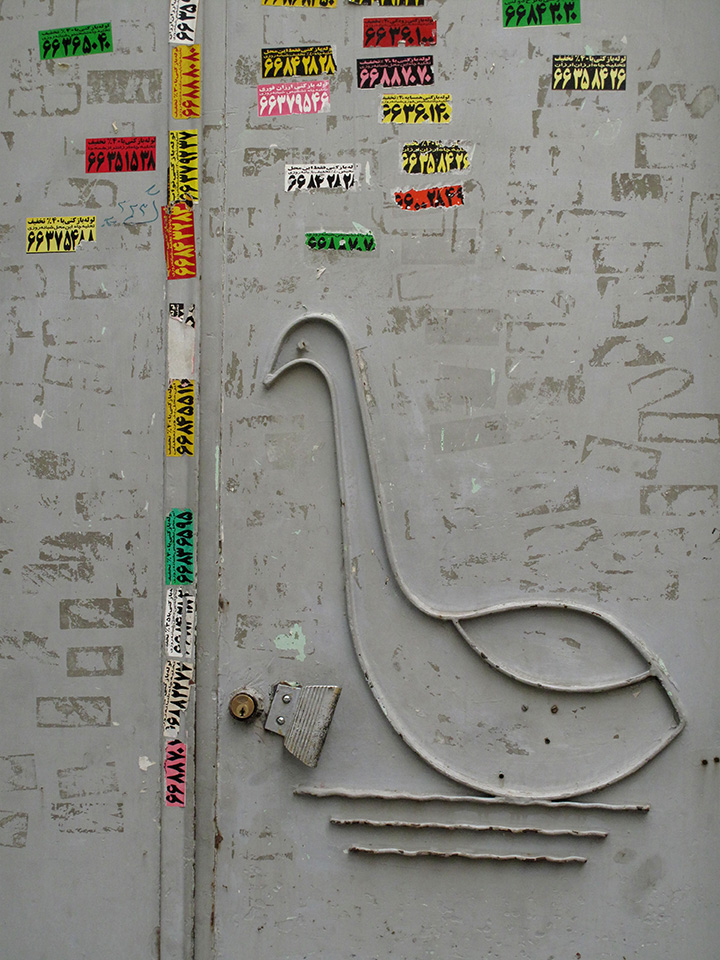
Narrative:I am studying about a style of doors in my home country, Iran. They were common when I was a child. I have been taking pictures of them in the old neighborhoods in different cities during my travels since 2014. Recently, I have focused on making paintings of them in my studio practice.
I believe you can focus on the house, its structure and its elements to think and talk about the residents, family. The doors are interesting as a barrier between two different realms. They are the gates between intimate people and others. They are mysterious, closed and blocking. We can just stop by the door, look at it and imagine. I want to invite the audience to think about what is going on behind these doors. It could be something between a happy life and a disaster. The irony that they have fragile elements like flowers and animals out of metal on them is also appealing to me. Also, we can consider the surface of the doors as the third realm. Considering stranger people who put the sticker on the doors and went. Stickers that are not wanted and were tried to be removed.
Hannah Harris, KNR, Effects of Graston Technique on Blood Flow in the Upper Trapezius
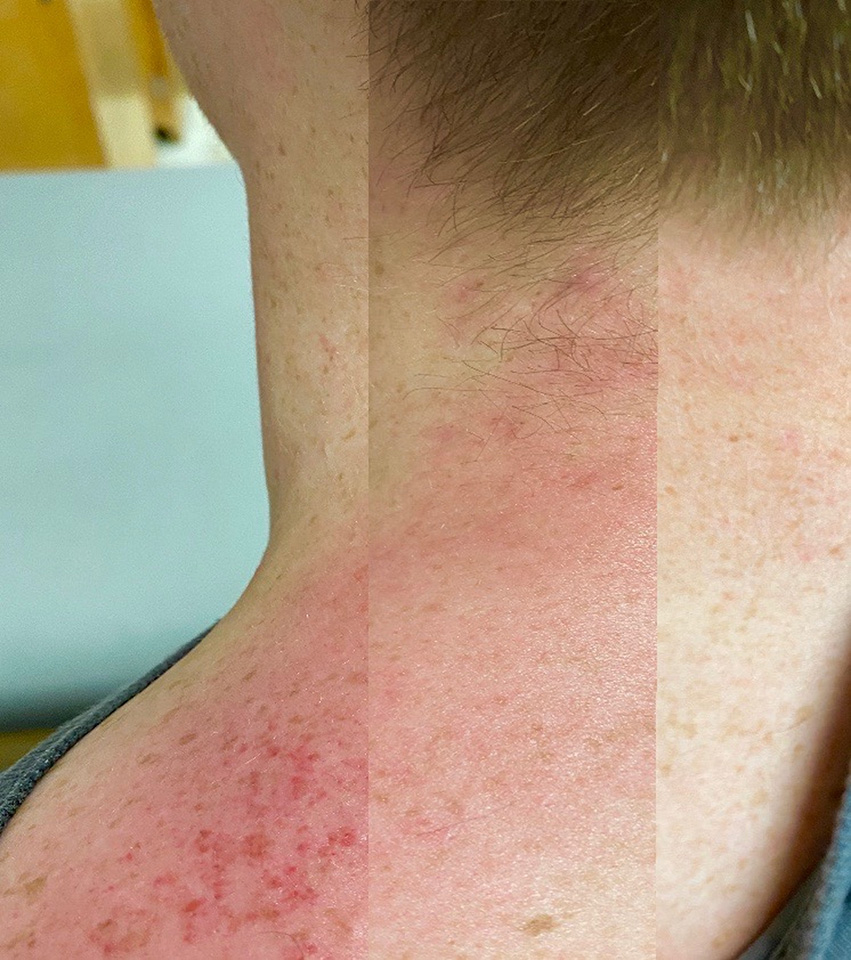
Narrative:The purpose of this research study is to examine the effects of Graston Technique on blood flow in the upper trapezius muscle. Non-specific neck pain effects two-thirds of the general population commonly due to trigger points present in the upper trapezius muscle. Daily activities such as sitting at desk, working on a computer, driving, and others lead to poor posture. Poor posture influences the upper trapezius muscle activity causing the muscle to become taut. When a muscle becomes taut the amount of blood flow received by the muscle tissue is decreased leading to the formation of trigger points. Graston Technique uses stainless-steel instruments with beveled edges to break down tight muscle tissue and increase blood flow to the treated tissue. Looking at this image from right to left, the skin appears to redden over the five-minute treatment time. This image displays the visible increase of blood flow to the treated muscle tissue over time during an application of Graston Technique. As the instrument is applied to the muscle tissue, blood flow rises to the surface becoming visible on the surface of the skin. An increase of blood flow to a taut muscle trigger point will provide a healing environment.
Spencer Molnar, Art, Constructing Meaning Through Experience
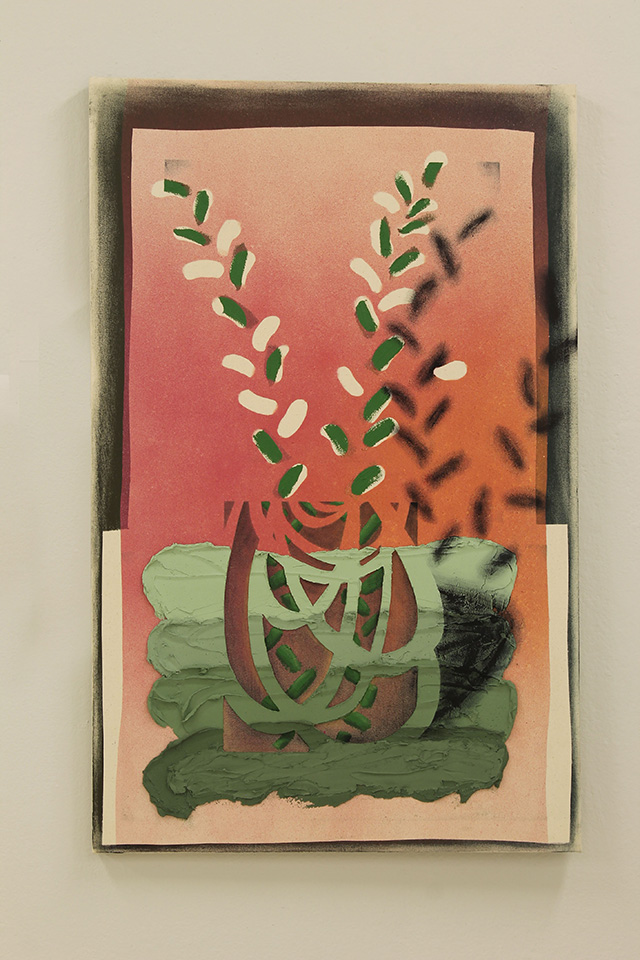
Narrative:Whether looking from above or below, or attempting to understand different political opinions, it is hard to refute the fact that in daily life we are constantly confronted with different perspectives. My research and exposure to different philosophies and visual psychology have fostered the notion that attempting to understand the world through multiple perspectives is natural to human behavior and psychology. It seems as though humankind has eternally strived to reconcile seemingly opposing views. In a sense, you might say that collectively (and individually) we have attempted to make “wholes” out of fragments. One of the most widely accepted forms of visual psychology that explains this phenomenon would be the gestalt principal of closure. Closure attempts to explain how human perception is inclined to see forms in a complete state despite the absence of one or more of their parts. One seemingly opposing perspective to gestalt can be observed in the philosophical idea of anatta, which is a Buddhist doctrine that identifies a person’s “self” as constantly undergoing change, therefore making a “self” imperceptible. My claim is that closure allows individuals to distinguish a “self” through phenomenal experience. This is not dissimilar to the concept of constructing meaning from experience.
Ian Rines, Biology, Cricket Conflict
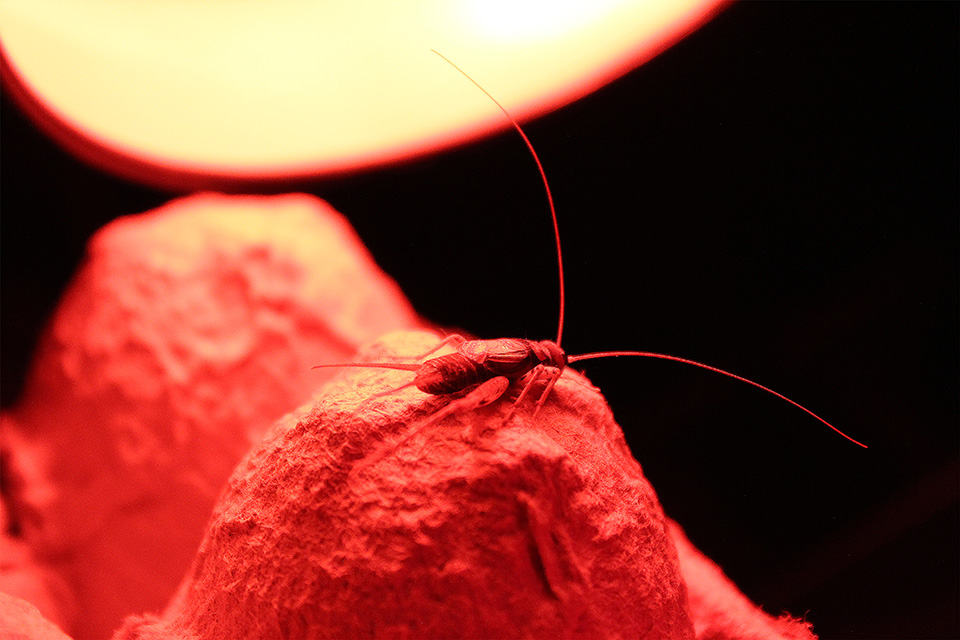
Narrative:Although we think of sexual reproduction as inherently cooperative, it is frequently beset with conflicts of interests between the sexes. Conflict surrounds mating and the paternity of offspring: males gain by monopolizing fertilization of a female’s eggs, while females benefit by pursuing matings with other males. I investigate this conflict of the sexes in the decorated cricket, Gryllodes sigillatus; a male of this species is pictured here. My research focuses on how males manipulate females during reproduction via chemical compounds in their ejaculates, which I do by sitting in red-lit dark room and watching crickets have sex. We are not certain of the exact mechanism by which males manipulate females, but we now have reason to believe that male-derived proteins transferred at mating may be responsible. My research aims to determine the role of these proteins in manipulating female behavior and physiology, specifically female sexual receptivity and egg-laying behavior. As the mechanism underlying the female behavioral change has not been established, my work aims to take a novel functional genomics approach to deconstruct the molecular underpinnings at the heart of this sexual conflict in these crickets.
Rocky Roque, Communication, Recoloring a Colorless Community: The Rhetoric and Discourse over the New Pride Flag

Narrative: I wrote a research paper articulating the prevalence of racism in the LGBTQ community. In my paper, I rhetorically analyzed the black and brown striped pride flag to examine the discourse it has created. Using theories from McGee’s diachronic dimension, Gramsci’s concept of hegemony, and McKerrow’s critique of domination, I summarized that the pride flag has been a branded symbol for the community. The new pride flag was created to disrupt this branded symbol and protest the racism black and brown queer individuals experience. I further discuss the pride flag’s ever-changing ideology, how racist members reinterpret the new flag’s intention, and its implications. Additionally, I presented my research paper at the 2020 Midwest Bisexual, Lesbian, Gay, Transgender, Asexual College Conference. I discussed my findings and shared narratives of my encounter with racism in the community. Additionally, I confronted oppressors and conducted a discussion. This photo was captured during my presentation. The picture is a symbolic representation of my protest, because I am standing in front of the new pride flag to show my resiliency and pride of being a person of color in the LGBTQ community.
Bret Williams, Creative Technologies, Just a Little Light Reading
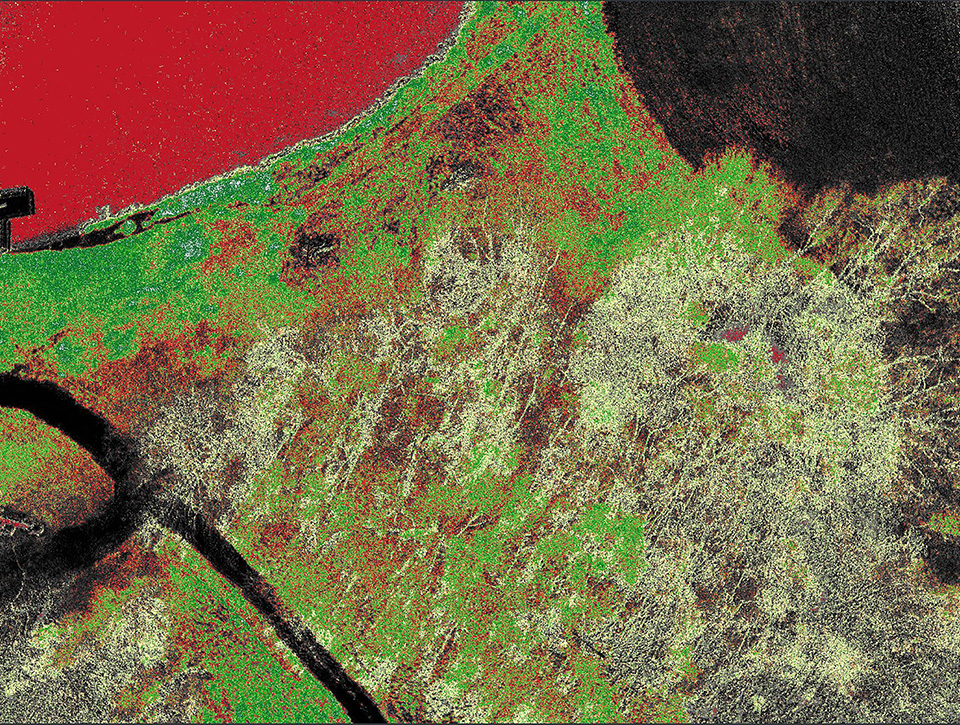
Narrative:This image was taken by a MapIR spectral imaging camera attached to an autonomous UAV 180 feet above a 230-acre farm plot in Mount Sterling, IL. The UAV successfully took off, mapped the acreage, and landed autonomously allowing the surveyor to download the images after the fight for calibration. A color LUT has been applied to the image showing areas of healthy vegetation in green, moderate vegetation in yellow, and low to no vegetation in red and black. Each image details the amount of sunlight absorbed by the surrounding field recording light levels and NIR information before the image is calibrated. This type of photography can determine whether a field is suffering from a lack of sunlight, water, or nitrogen and can also determine insect or fungi damage. This program was launched as an independent study in the summer of 2019 but was later unable to obtain permissions from the Research and Sponsorship's department to further its research. If successful, this program could help diminish over-spraying of pesticides and nitrogen allowing the surrounding environment and ground water to become less polluted and giving farmers hours instead of weeks for faster turnarounds and better overall yields.
Undergraduate Winners and Finalists
-
First Place: Radiance Campbell "Consent and Intent"
Prize: $200 -
Second Place: Chris Apuzzo "Visualizing a Microscopic Process of Astroglia Cells"
Prize: $150 -
Honorable Mentions: Arianna Garcia "Envisioning the Lawn as Landscape"; Emily Killian "Dystrophin promoter fusion C. elegans"; Emily Swiderski "Female Communicable Disease and Depression Rates Correlational Study"
Prize: $50 -
Peoples' Choice: Radiance Campbell "Consent and Intent"
Prize: $150
Chris Apuzzo, Chemistry, Visualizing a Microscopic Process of Astroglia Cells
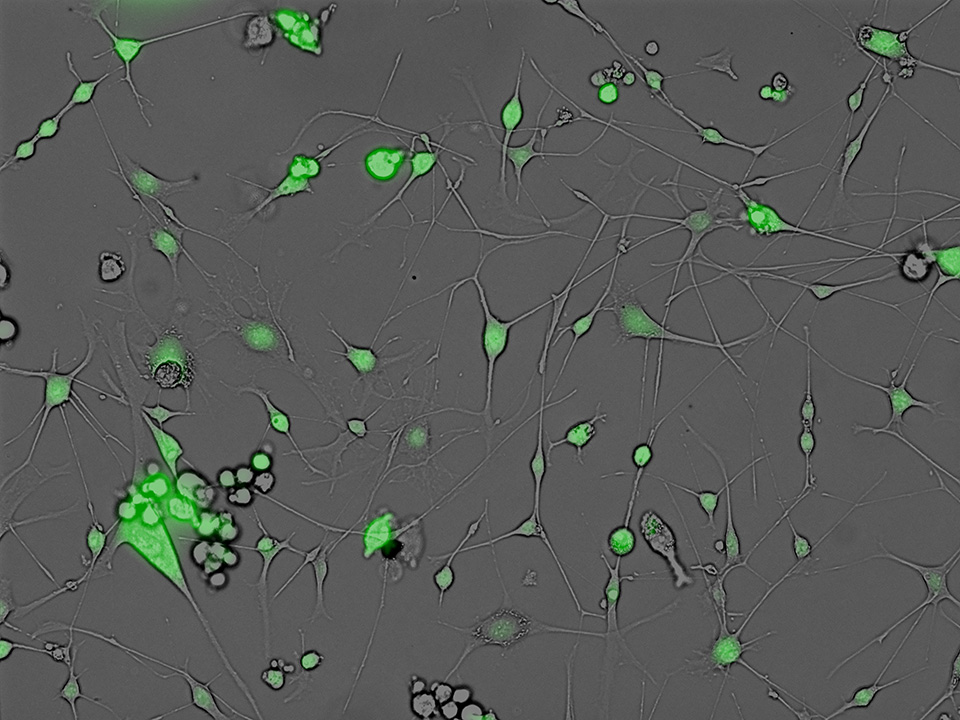
Narrative:In addition to neurons and other types of glial cells, astroglia are distinct star-shaped cells found in the brain and spinal cord. Astroglia play important roles in degenerative neuropathic pain by producing and consuming certain chemical species that correlate to cell stress. This image is the result of an overlay of a fluorescent-captured microscopic image with a direct image of astroglia cells. The green-colored cells are observed after incubating the astroglia with a specific chemical probe for our chemical of interest - nitric oxide. The more intense the green in each area, the higher the concentration of the nitric oxide. Nitric oxide is an important messenger between the astroglia and surrounding neurons and is proposed to be correlated with relief from pain. Forming this overlay allows us to visualize the localization of this chemical within the astroglia and compare it to astroglia experiencing different environmental conditions. We can then compare the production rate of the nitric oxide and how changing the environment affects this. Finding conditions that increase or decrease production for this molecule is important for the development of therapeutic treatments for people who experience neuropathic pain.
Radiance Campbell, Sociology, Consent & Intent
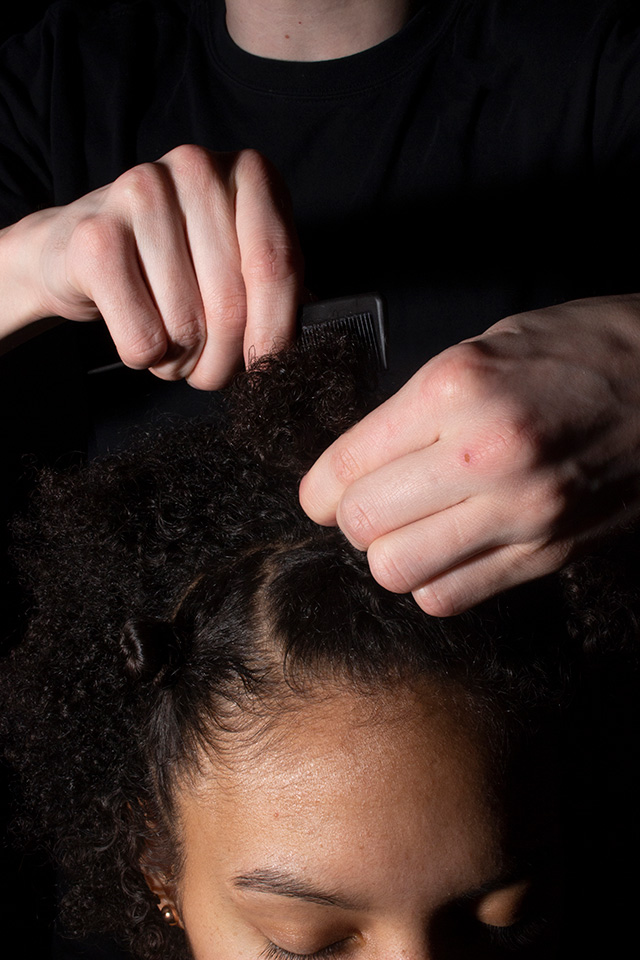
Narrative:This image is one of many taken for “Performing color: Participatory photo and community based research in a modern U.S. circus” to represent the experiences of POC in Gamma Phi Circus. As a black feminist researcher, I am primarily concerned with giving my subjects control over telling their own stories; they become equal partners in the collection, processing, and representation of our data. This particular image is about inclusion. It is about our struggle to be included in white-dominated spaces, where our needs or culture are not easily understood. It’s also about moments of radical inclusion that we wish were more normal, like when a white circus member learns to do our hair in a special style for a show. The intimacy and trust depicted here contrasts heavily with the norm of people gawking or touching without permission. We want to show that it doesn’t have to be “us vs them”— we’ve seen people grow, and we hope others will choose to grow, too. This is the story of people learning, across racial lines, how to treat each other. It’s not always about color— we hold as tightly to our allies as we do to each other.
Arianna Garcia, Art, Envisioning the Lawn as Landscape
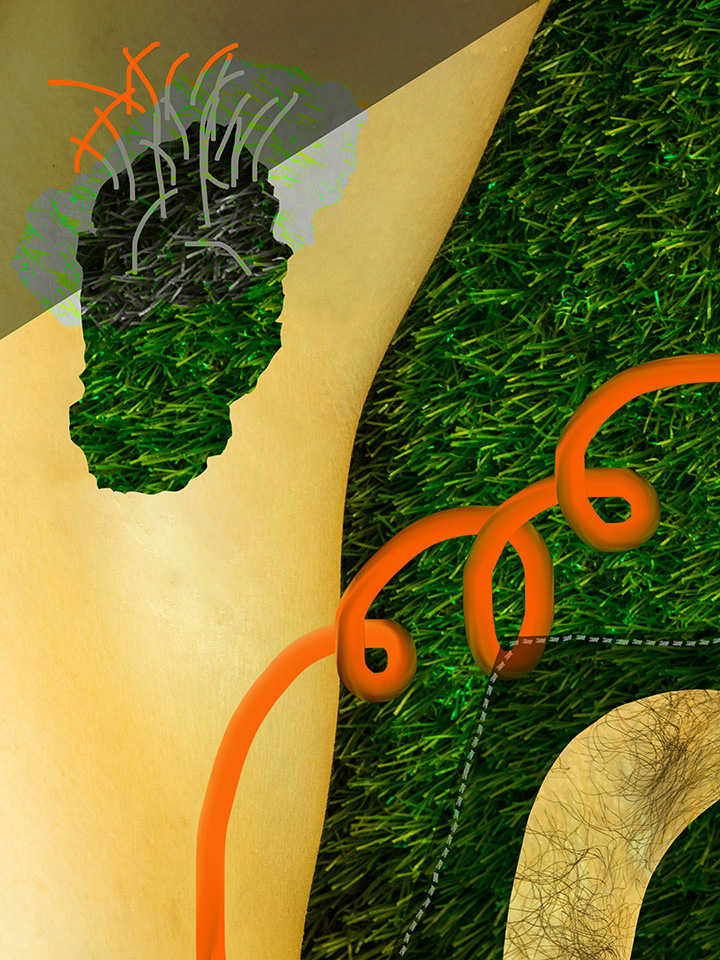
Narrative:Recently, I’ve been interested in studying Lawn as Landscape and investigating the autonomy we often hand over to it. Our yards take up so much of our energy and resources without their prerogatives being contemplated. We welcome the Lawn with open arms, adorning it with the latest hairstyles; always keeping it hydrated. On the contrary, some of us neglect this terrain, offering it a new, more political dynamic. These personal choices and their multi-layered effects allow us to envision the Lawn as a microcosm of contemporary ecological discourse. By investigating this complex relationship, we'll find that these intricacies can be discovered throughout contemporary society. The Lawn is a verb as much as it's a noun, and whether it's one or the other depends on the Landscaper. I’m aiming to take on the role of Landscaper to open a dialogue that works to reclaim this as a space that isn’t ruled by a binary. By rejecting expectations that have been placed on it, it's able to act as an extension of ‘domestic’ space; a conversation between inside and outside that’s constantly ebbing and flowing. Namely, a blurring of where one place ends and the other begins-- a queer space without boundaries.
Rachel Johnston, Biochemistry, Colorful Properties of Azulene
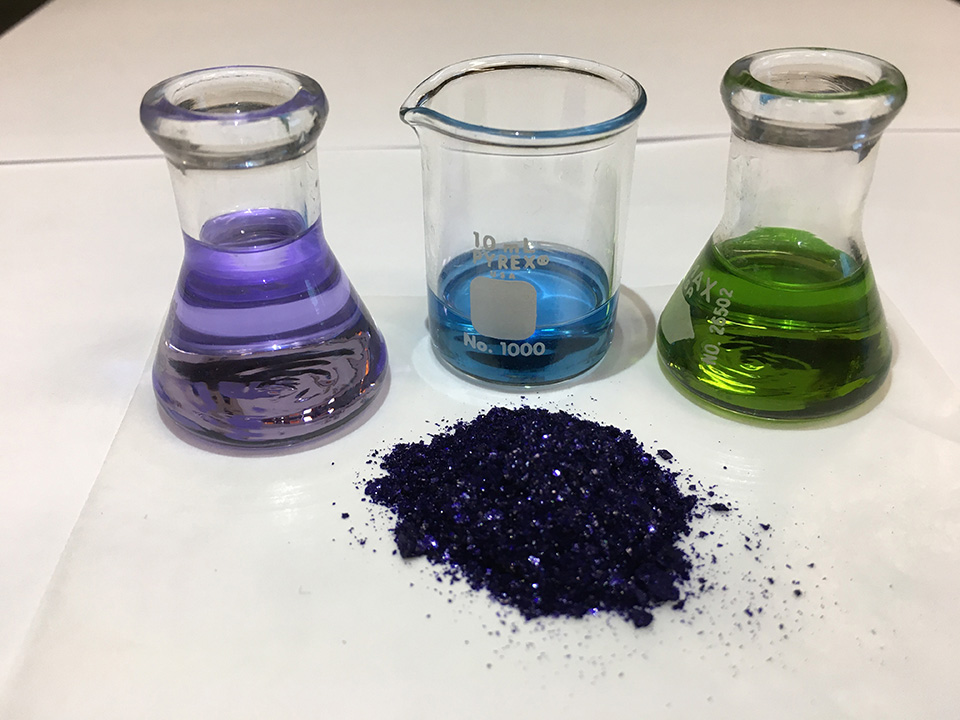
Narrative: Porphyrins, commonly known as the pigments of life, give rise to the vivid colors associated with blood and green leaves. They are large aromatic species whose colors result from their electronic properties. Smaller aromatic compounds are usually colorless but azulenes, a two-membered aromatic ring structure, are commonly deep blue or purple. The image shows the unique colors of some azulene derivatives. The azulene crystals (foreground) sparkle and exhibit a dark indigo color, while a solution in dichloromethane (left) has a distinctive purple color. We are investigating the synthesis of porphyrin-like molecules that incorporate azulene rings. An intermediate was prepared by adding two pyrrole rings to form an azulitripyrrane. The middle beaker contains a solution of this intermediate and shows a striking change in color from the original purple to blue. Further reaction with a pyrrole dialdehyde afforded an azuliporphyrin. The Erlenmeyer flask on the far right contains a dilute solution of the azuliporphyrin and this shows a distinctive shift from blue to a deep olive green color. These results demonstrate how the properties of the azulene ring system can be dramatically altered and thereby produce compounds with radically differing coloration.
Emily Killian, Biology, Dystrophin Promoter Fusion C. Elegan
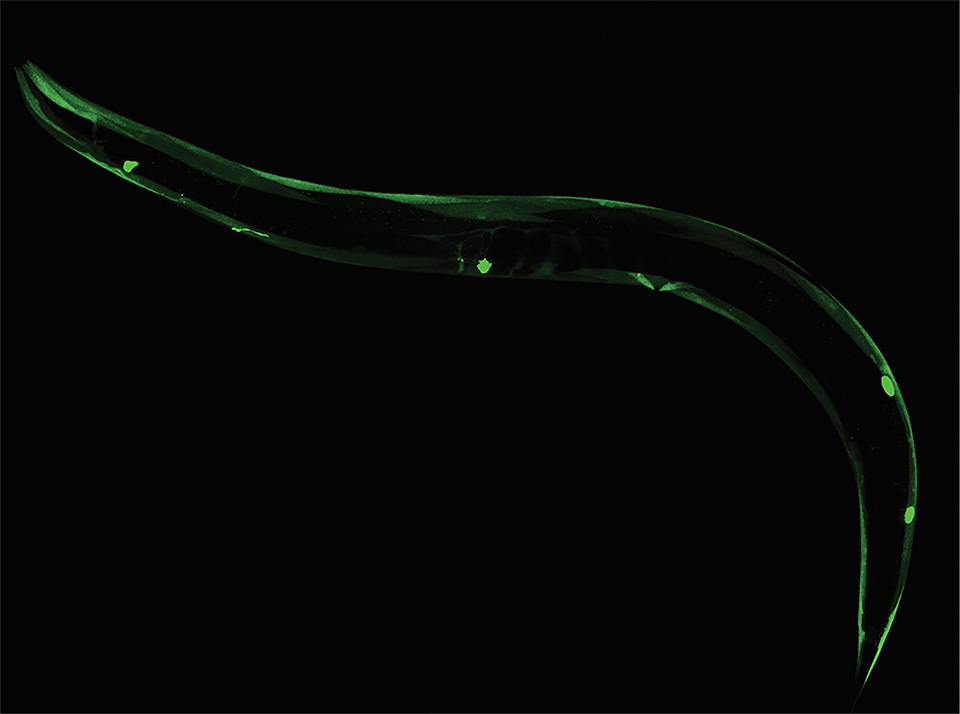
Narrative: My research in Professor Vidal-Gadea's lab has consisted of studying which versions of the protein dystrophin are present during exercise in the microscopic worm, C. elegans. This image depicts green fluorescence seen when the long version of dystrophin is expressed. To create this image, we injected a small piece of DNA, our fusion product, into a C. elegans. The fusion product consists of a promoter region of the long version of dystrophin connected to green fluorescent protein (GFP) and an unc-54 3’ untranslated region (UTR). The promoter controls where and when the fluorescence is expressed, and the UTR tells the animal to make a lot of fluorescence. So, everything green in the image is where the long version of dystrophin is located. The next step in our research is to inject the same worm with the short isoform dystrophin promoter, which will show up red in the image. With this data, we will be able to compare red to green fluorescence, which will tell us the ratio of short to long dystrophins being expressed.
Alex Plumadore, Physics, Twisted Identities
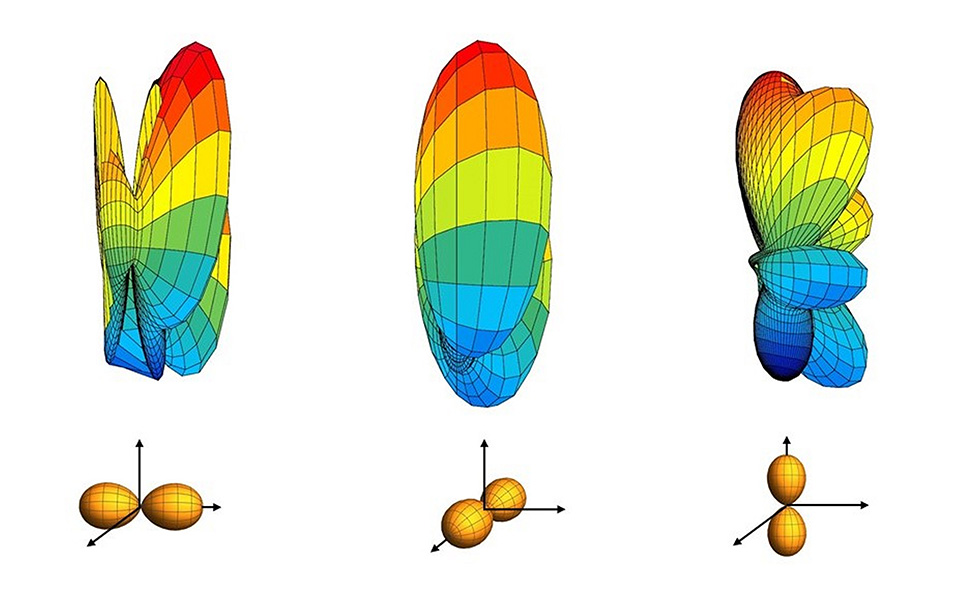
Narrative: Humanity has been striving to understand the universe for thousands of years. Today, this understanding has taken a leap forward as a new advancement called electron vortex beams are being used to probe deeper into the unknown. These new beams have a unique twisting that leads to potential applications in communications, microscopy, astronomy, and identification of atomic structures. In order to access these applications, a fundamental understanding of these twisted beams, and their interactions with matter, is required. To gain this deeper insight into twisted beam interactions with matter, we calculate the probability of finding an electron emitted from a collision between the twisted beam and a hydrogen atom. This image shows the results of our calculations by 3-D graphically representing the probability of finding the emitted electron at a specific location (top row) for different atomic structures (bottom row). A larger bubble indicates a greater likelihood that the emitted electron will be found there. Our results show the emitted electron probabilities can be used to determine the atomic structure.
Emily Swiderski, Nursing, Female Communicable Disease and Depression Rates Correlational Study

Narrative: The prevalence of Sexually Transmitted Infections (STI) has rapidly increased in the United States (US), burdening the public health sector. According to the Centers for Disease Control (2019) STIs prevalence for syphilis, gonorrhea, and chlamydia affected more Americans in 2018 than any other time in history. Chlamydia has increased 19% to 1.8 million cases in 2018. Gonorrhea rates increased by 63% to 583,405 cases in 2018 from 2014. Syphilis infection rates increased to 35,063 new cases of primary and secondary Syphilis (71%) since 2014. Congenital Syphilis incidence rose with 1,306 new cases (185%) since 2014. Research has linked multiple issues with increased STI prevalence, such as: illicit drug use, social determinants, and decreased access to STI screening and prevention resources (CDC, 2019). There is also evidence linking STI with depressive symptoms internationally (Jackson, Seth, DiClemente, & Lin, 2015), but less research focused on females within rural Midwestern settings. This correlational study will test for statistically significant associations between depressive symptoms and STIs in a Central Illinois medically underserved female population. This study hypothesizes females who screen positive for depression may have increased incidence of STIs.
Ashley Tauber, Biology, Wren Crew Experience
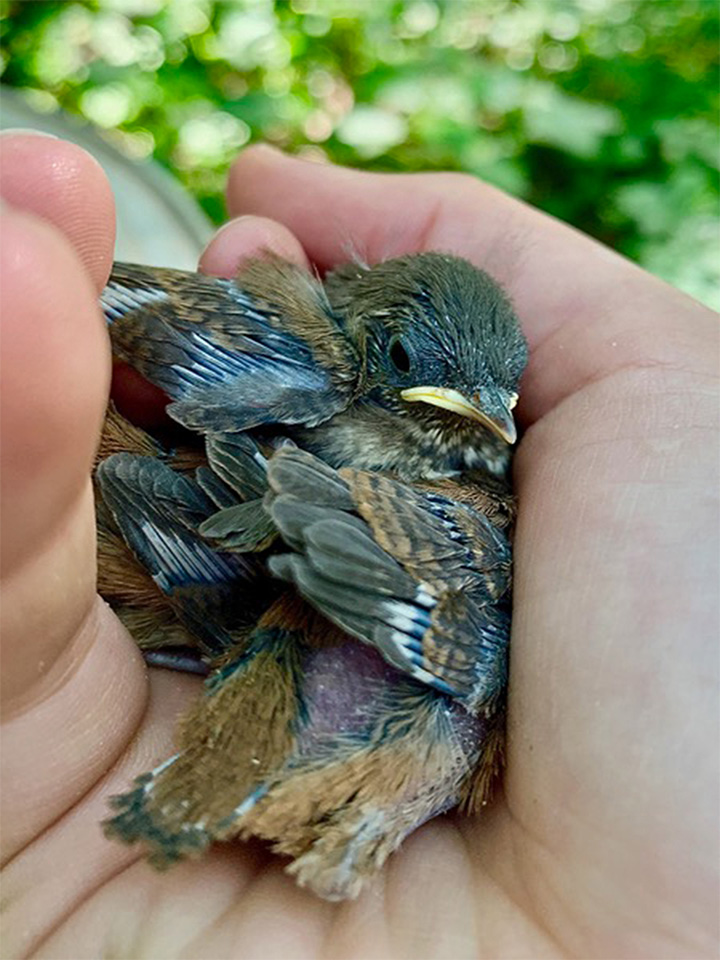
Narrative: This past summer, I gained hands-on research experience with Wren Crew, a lab dedicated to understanding the ecology and behaviors of the House Wren. This small, whimsical bird is common to Illinois; its bubbling and exuberant song has filled the backyards of many with its cheerful melodies. My responsibilities for the lab included: capturing, weighing, banding, and measuring the wings and tails of adult wrens and weighing and banding the nestlings. It is a fascinating feeling, having a wild bird (or handful of nestlings) in the palm of your hand. You feel their rapid heartbeats, their warmth, and the smoothness of their feathers. I couldn't help but be amazed at how breath-taking those birds were. After releasing the adults or gently placing the nestlings back in their nest box, I realized how privileged I was for the opportunity to have that intimate encounter with them. For Summer 2020, I am rejoining the team and will be working on my own personal research project. Spending time with the wrens has opened my eyes to how much more I could learn about them and how blessed I am to have the classroom knowledge to apply to my projects in the field.